What Is An R&D Lab?
A research and development lab, or R&D lab, is a laboratory type used in virtually every production industry. These labs have a heavy focus on prototyping and experimentation and exist to promote in-house innovation and inventing.
R&D allows a company to stay ahead of its competition, and a dedicated R&D lab can allow companies to design new products and improve their existing offerings. R&D labs have faced fluctuating popularity over the years as various industries have relied on different sources of innovation.

The Importance of R&D
Research and development are an enormous part of the global economy. Even though most companies only spend 5-10% of their budget on R&D, it is still a multibillion-dollar industry in the United States and abroad.
In 2019 , business R&D spending totaled $463.7 billion, while government spending on R&D was budgeted at $138.9 billion. That’s over half a trillion dollars in R&D spending in the United States alone!
The United States is the global leader in the amount of money spent on R&D, although South Korea and Israel spend a greater percentage of their GDP.
Research and development isn’t just an important economic sector, though– R&D is responsible for innovation and new technologies and products. Any projects that companies carry out to gain knowledge in their field fall under the umbrella of R&D.
These projects lead to new scientific or technological advancements that can then be used to create new or improved products and services that the company can then use or sell. Nearly every successful company, regardless of its size and industry, carries out R&D at some point.
The R&D Process
R&D is not a simple research process, and this is important to take into consideration when building an R&D lab. A business needs to account for the stages of work that must be done for proper project development.
It is a three-stage process wherein each stage builds on the results of the prior stage. There are typically three different stages of the R&D process, no matter what industry you’re in or what type of lab you run: Basic Research, Applied Research, and Development Research.
Basic Research
When the research objective is to fully understand one particular subject area, rather than any practical application, it’s classified as basic research. Basic research is concerned with the pursuit of a particular scientific advancement without any specific commercial aims.
This research is foundational to the other types of research because to understand how advances can be made, a good understanding of the fundamentals is necessary. The primary outcome of basic research is to provide the first steps in developing a strategy and finding a solution, while also giving the company a better understanding of current trends in the market.
Whatever basic research looks at, R&D physical or data scientists approach it while considering the big picture.
Applied Research
Applied research takes the outcomes from basic research and applies them to determine commercial applicability for new or existing products and services. Applied research is concerned with determining possible uses for the results of previous basic research, or in finding new ways of achieving a specific goal using those prior basic research results.
It forms the second step in the R&D process and lets the R&D team identify solutions, resolve issues, and take advantage of any industry trends.
Development Research
Development research is the third part of the R&D process. It involves working systematically on a project using existing knowledge gained from research or practical experience to develop a new product, service, or process.
Engineers, data scientists, material scientists, and manufacturing teams can bring ideas to life and ultimately create something that can be sold on the marketplace. New processes brought about by development research can also be used by the company in more effectively and efficiently marketing their products.
The result of development research is often something tangible or an end-stage process that can be used by consumers or other members of the industry at large.
Types of R&D Labs
While any industry can participate in R&D, some industries rely more heavily on it than others. Here are some examples of R&D labs and what is researched for specific industries.
- Chemical R&D Labs : chemical processes for manufacturing
- Communications R&D Labs : VOIP and other data transmission technologies
- Manufacturing R&D Labs : new products and industrial processes
- Materials Science R&D Labs : material development, new uses for existing materials, polymers
- Medical R&D Labs : medical technology, prosthetic limbs, suture material, surgical closures
- Nanotechnology R&D Labs : microchips for phones, computers, and other technology; nanobots and other tiny technologies
- Pharmaceutical R&D Labs : medications, vaccines
- Software R&D Labs : AI, computer programs, algorithms
- Technology R&D Labs : computer processes, computing technology
How An R&D Lab Can Help Your Business
Back in the 1970s and 1980s, huge firms like DuPont Chemical dominated the R&D market across various industries. That is no longer the case.
The majority of R&D isn’t done by these massive companies; it’s done at small startups or as an offshoot of academic research. This means that R&D labs are experiencing more independence than ever before.
Contract research means that smaller businesses can experience great success in the R&D field, as big companies are often more interested in buying the results of research than investing in the first two parts of the R&D process. A smaller business can set itself up as an R&D expert and run multiple labs for multiple industries, then sell the results and return to research.
R&D Lab Planning
Because R&D is done in so many industries, each lab setup type is different. If your industry involves manufacturing, you’ll need CNC machines and 3D printers for rapid prototyping. You may need welding tables , ESD lab tables , or other highly specialized lab furniture.
If you’re in the pharmaceutical or chemical industries, you’ll need access to various types of chemicals and the equipment needed to work with them. You will need safety equipment like fume hoods and biosafety cabinets .
Whether your intended R&D lab focuses on materials science or medical research, you will need various pieces of equipment and lab furniture arranged in a workspace that promotes good workflow and ergonomics.
At OnePointe Solutions, we are experts at building custom casework , countertops , lab tables , and other lab furniture and equipment that will improve your lab’s workflow and efficiency. The time and expense of customizing your lab equipment are worth it; with lab furniture that’s designed specifically for your R&D lab’s needs, your lab’s operations will run smoothly and you will be able to feel secure and satisfied knowing that everything in your lab is top of the line and guaranteed to perform beyond expectations.
OnePointe Solutions is a leading laboratory construction and design firm, scientific furniture manufacturer, and lab builder. Our project history ranges from classrooms to Biosafety Level 3 and 3+ enhanced labs .
Need Help With Your R&D Lab?
Regardless of industry and regardless of lab size, our expert laboratory design team can come up with a plan that’s perfect for your R&D lab. Contact us or give us a call at 866-222-7494 to speak to a lab design specialist today!
Questions? Concerns? Want to start today? Get in touch. 866.612.7312

- ANAB Accreditation
- Forensic Anthropology
- Missing Persons
Research and Development
News and Media
Submission Forms
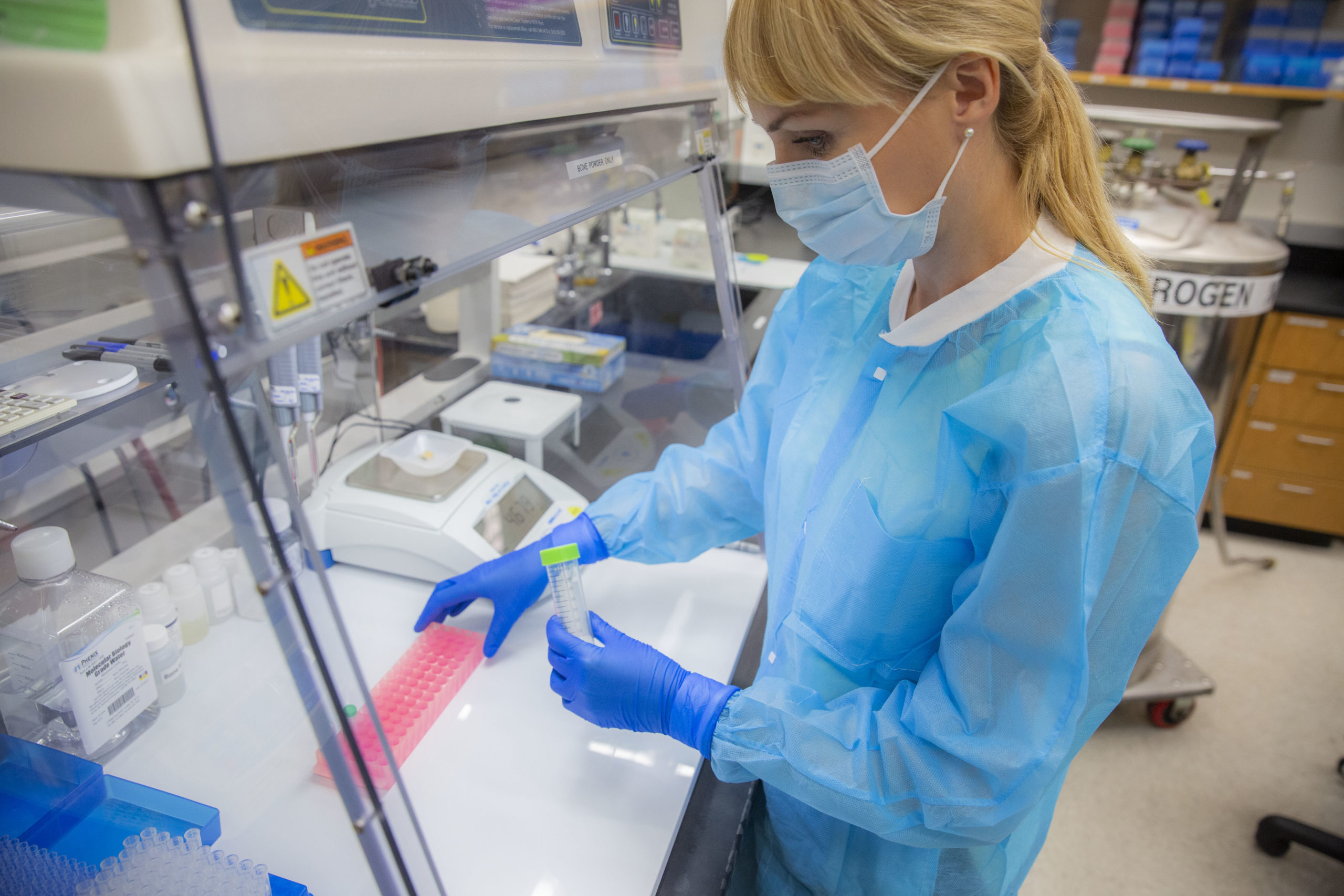
Michael Coble | CHI Executive Director

Dr. Michael (Mike) Coble earned his PhD in Genetics from The George Washington University in 2004. After receiving his doctorate, he was an NRC Postdoctoral Fellow and, later, a Research Biologist in the Biotechnology Division of the U.S. Department of Commerce's National Institute of Standards and Technology (NIST). He then spent four years as the Research Section Chief at the U.S. Department of Defense's Armed Forces DNA Identification Laboratory (AFDIL), where he assisted on numerous identifications, including the widely publicized positive identification of two of the children of Tsar Nicolas II and his wife Alexandra. After eight additional years as a Forensic Biologist for NIST, Dr. Coble joined the Center for Human Identification as Associate Director in 2018, and was appointed acting Executive Director on February 1, 2022.
Dr. Coble's research focuses on issues associated with DNA mixture interpretation and he, literally, wrote the book on probabilistic genotyping. Other areas of research include haploid marker systems for forensic testing (mitochondrial DNA and Y-chromosome testing), and non-traditional marker systems to gather genetic information from challenged and deteriorated samples (X-chromosomal STRs, insertion-delete markers, etc.).
While at CHI, Dr. Coble has been instrumental in furthering efforts to reduce human trafficking and identify missing persons by assisting on a grant from the U.S. State Department to train and outfit forensic labs in Central America. He has also assisted the Texas Department of Public Safety Forensic DNA Laboratory, providing analysts with supplemental training in likelihood ratios and probabilistic genotyping.
Dr. Coble serves as a commissioner for the Texas Forensic Science Commission and is a Fellow of the American Academy of Forensic Sciences. He is a member of the International Society of Forensic Genetics, an invited guest at the Scientific Working Group on DNA Analysis Methods (SWGDAM), and serves as an affiliate of the OSAC Human Biology Subcommittee.
https://experts.unthsc.edu/en/persons/michael-coble
August Woerner | Assistant Professor

Dr. August Woerner received his PhD in Genetics from the University of Arizona in 2016, and has a PhD minor and M.S. in Computer Science (CS) from the same institution. August worked for a dozen years as the lead bioinformaticist in Dr. Michael Hammer's population genetics/genomics research group, all whilst completing undergraduate and graduate CS coursework. August considers himself to be a biologist who codes (instead of a computer scientist who interacts with biology). In general, he is interested in practical solutions to open problems in multi-omics, genomics, and forensic genetics. August has many research interests that vary from better computational approaches, to read mapping and DNA sequence alignment, to the application of machine learning models to make better predictions from the genome, as well as like models that reduce the appearance of noise in such systems.
August also cares deeply about fostering and teaching computational techniques to the next generation of biologists. Biologists are becoming ever-forced into handling, interpreting and understanding large datasets. Working with big data is challenging (as a matter of both practice and principle). He is an open proponent of borrowing from techniques in data science, especially data science as found in Hadley Wickham's tidyverse ( https://www.tidyverse.org/ ), to make big data more tractable. With such approaches, rather than spending years honing one's computational and programming skills, less effort can be spent to obtain results that are correct (easy to say, hard to do), that scale to "big data", and are reproducible. While the theoretical ceiling of such approaches can be limited, the immediate benefits (a few months of training to get ~80% of what a proper undergraduate and graduate degree in CS might give) make for an excellent tradeoff between investment (time) and reward (real insight into one's experiment).
August also has open interests in purely computational problems, such as techniques for context-specific alignment (read-mapping), machine learning and introducing machine learning techniques that apply to datasets that are not "rectangular" and perhaps are even non-numeric (i.e., to data that are opaque).
https://experts.unthsc.edu/en/persons/august-woerner
Jennifer Churchill Cihlar | Assistant Professor

Jennifer received her Bachelor of Science degree in Biochemistry from Texas A&M University. Her undergraduate research at Texas A&M involved the application of molecular genetic technologies to the study of population and conservation genetics of the North American bison. Jennifer earned her PhD in Biomedical Sciences, specializing in Human and Molecular Genetics, at the University of Texas MD Anderson Cancer Center UT Health Graduate School of Biomedical Sciences. Her dissertation work focused predominantly on the use of linkage and next-generation sequencing technologies to identify novel autosomal dominant Retinitis Pigmentosa genes.
Jennifer currently works with the Research and Development Unit at HSC's Center for Human Identification. Her research focuses on the development and application of human identification genetic marker analyses with massively parallel sequencing technologies, including the validation and implementation of massively parallel sequencing for mitochondrial DNA analysis into CHI's Missing Persons Unit.
https://experts.unthsc.edu/en/persons/jennifer-cihlar
Benjamin Crysup | Research Assistant Professor

Benjamin Crysup obtained BS degrees in Chemical Engineering and Computer Science at the University of Texas. He then followed them up with a PhD in Scientific Computation from Florida State University, by doing methods development to speed up molecular dynamics simulations. Being a computational chemist might make him the odd man out in the lab, but a collection of interesting computational questions both draws his interest and leverages his talents. When he's not coding, he's writing, running, making mead/melomel, or working on one of his many side projects.
Xuewen Wang | Research Scientist

Xuewen Wang received his Ph.D in Molecular Genetics from King's College London, University of London, United Kingdom, and obtained his Master's and Bachelor's degrees from College of Life Science at Peking University, China. He then conducted post-doctoral research at the University of Georgia. He worked as a leading scientist and leader of the China Tobacco Gene Center for National Tobacco Genome Project, a principle investigator at the Chinese Academy of Science, and later worked at an adjunct position with the University of Georgia and US Department of Agriculture for Genomics and Bioinformatics Research Service. He joined the Center of Human Identification at UNTHSC in June of 2021.
Dr. Wang's research focuses on bioinformatics and genomics at a large data scale with high performance computing facilities. He has rich experiences in next generation (2 nd e.g. Illumina and 3 rd , e.g. PacBio) sequencing (NGS) data analysis, especially for genome assembly, graph pan-genome, variants discovery, sequence comparison, population or single cell genomics, gene-trait associate, and integrated omics analysis of transcriptomes and metabolomes. He also developed many bioinformatic pipelines and several novel bioinformatic software, e.g. GMATA, to facilitate NGS data analysis and applied genomics. He has published more than 50 high impact research articles at Nature Biotech and Nature Communications etc., and his articles have been cited worldwide. He serves as an active reviewer and editor of more than 50 peer-reviewed academic journals.
He is currently working on projects that apply state-of-art technologies in bioinformatics and genomics to develop novel software and technology, to advance the research and service in human DNA identification with high-throughput sequencing, and to solve challenging problems in forensic science.
- Google Scholar
Meng Huang | Research Scientist

Meng Huang is a Quantitative Genetics Scientist with experience in the research fields of human genetics, animal breeding, and plant breeding. His research interests focus on the development of novel statistical analysis software, parallel computing, and big dataset analysis.
Jonathan King | Research Laboratory Director

Jonathan King is originally from North Carolina, but has lived in Texas long enough to be considered a naturalized Texan. He received his MS from Tarleton State University in 2009 with a research focus in capturing novel polymorphic InDels from agricultural pathogens. He has been the laboratory manager for the research and development lab since March 2011. Jonathan currently serves on the ISFG-recognized scientific working group (STRAND) and the editorial board of Forensic Science International: Reports. Jonathan's current research projects include bioinformatics, massively parallel sequencing, small amplicon markers, mitochondrial DNA sequencing, microbial forensics, and molecular medicine, just to name a few. When he is not working, Jonathan enjoys photography, gardening, and the culinary arts.

Melissa Muenzler | Senior Research Associate
Melissa is originally from Austin, TX, and received her BS in Biology from Texas Tech University. She has no free time, due to her three children, but can quote the entirety of all four Toy Story movies. She enjoys working at the lab bench and takes great joy in a well-prepared library.
Jessica Broner | Research Specialist

Jessica Broner received her MS in Pharmaceutical Science with a concentration in Forensic DNA and Serology from the University of Florida and received her BS in Biology from the University of Arkansas at Little Rock. She is originally from North Little Rock, Arkansas. Her research interests include forensic biology testing techniques dealing with degraded samples, next-generation sequencing, and low-copy number typing and applications. In her free time, she enjoys reading mystery novels, watching anime, attending concerts, traveling, and spending time with her family.
Muyi Liu | Postdoctoral Research Associate

Dr. Muyi Liu received his bachelor's degree from the Computer Science Department at Tsinghua University, China. He graduated from both Biological Sciences Department and Computer Science Department at Purdue University, with Ph.D. and M.S. degrees, with a further two years of postdoctoral research training in the School of Medicine at Indiana University.
He has more than five years of experience in Single Cell Genomics, including RNA-Seq, ATAC-Seq, Spatial, genomics alignments, annotations, and gene differential expression analysis. He is also an expert on graph mining FSM, clustering algorithms, and NP problem reductions to Modern SAT solvers.
- Center for Human Identification
- CBH, 6th Floor | 3400 Camp Bowie Boulevard | Fort Worth, TX 76107
- Local Number: 817-735-5175 | Fax: 817-735-0553 | Toll-Free: 1-800-763-3147 | Toll-Free Fax: 1-800-221-3515
- Research & Development Lab
- Media Contact

© 2024 The University of North Texas Health Science Center at Fort Worth
- Texas Veterans Portal
- Mental Health Services
- Report sexual or behavioral misconduct
- Minors on Campus
- UNTHSC Trust Line
- Report Fraud, Waste or Abuse
- Non Discrimination
- Privacy Policy
What can we help you find?

We run to, not from, the world’s biggest health challenges.
The journey to discovery is guided by science – and inspired by patients
We use the power of leading-edge science to save and improve lives around the world. The path to discovery is often unclear, but we are tireless in seeking solutions for some of the world’s most difficult health challenges.
Our work in numbers
people employed in research and development
invested in R&D in 2023
Our areas of focus
We focus on scientific innovation to deliver medicines and vaccines that may help millions of people around the world.

Our team of researchers and scientists are pushing the boundaries of cancer research to discover more effective anticancer therapies.
Our work in oncology

Vaccines are one of the greatest public health success stories – and we’ve been discovering, developing, supplying and delivering vaccines to help prevent disease for over 130 years.
Our work in vaccines
Infectious diseases

Our focus has always been on the prevention and treatment of diseases that threaten people and communities around the world.
Our work in infectious diseases
Cardio-metabolic disorders

We have a long history of making an impact in cardio-metabolic disorders, such as type 2 diabetes and cardiovascular disease.
Our work in cardio-metabolic disorders
Discovery & development

We follow the science where we can make the greatest difference, now and in the future.
More about discovery and development
We address the world’s most difficult health challenges, following leading-edge science

Step inside Merck Research Laboratories (MRL) where our quest to save and improve lives through research and development begins

We’re focused on inventing new medicines and vaccines to help more people
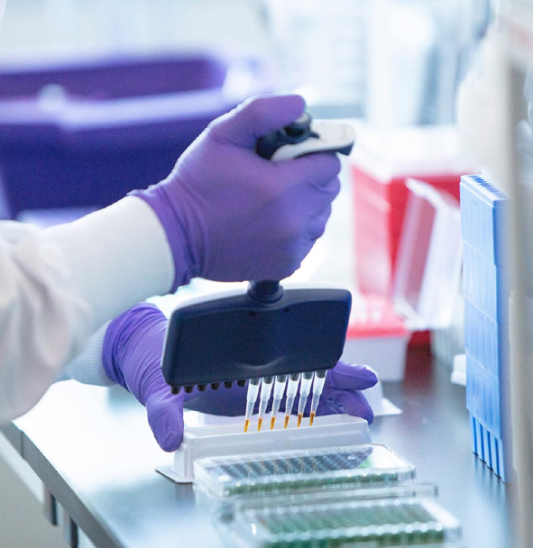
Our focus on breakthrough science is working

Clinical trials
Our progress is due in large part to the important and tough scientific questions we set out to answer with our trials and collaborations. We are grateful to the thousands of volunteers who participate in our clinical trials — making this all possible.

Our commitment to patients is unwavering
As long as there are still patients in hospitals, doctors and nurses desperate to add years to the lives of their patients, and a world where treatments aren’t accessible to all, we will be here, fighting with all we have to deliver more, sooner.
Discovery starts here
Our scientists are applying the latest groundbreaking research technologies and revolutionizing how we discover and develop medicines and vaccines
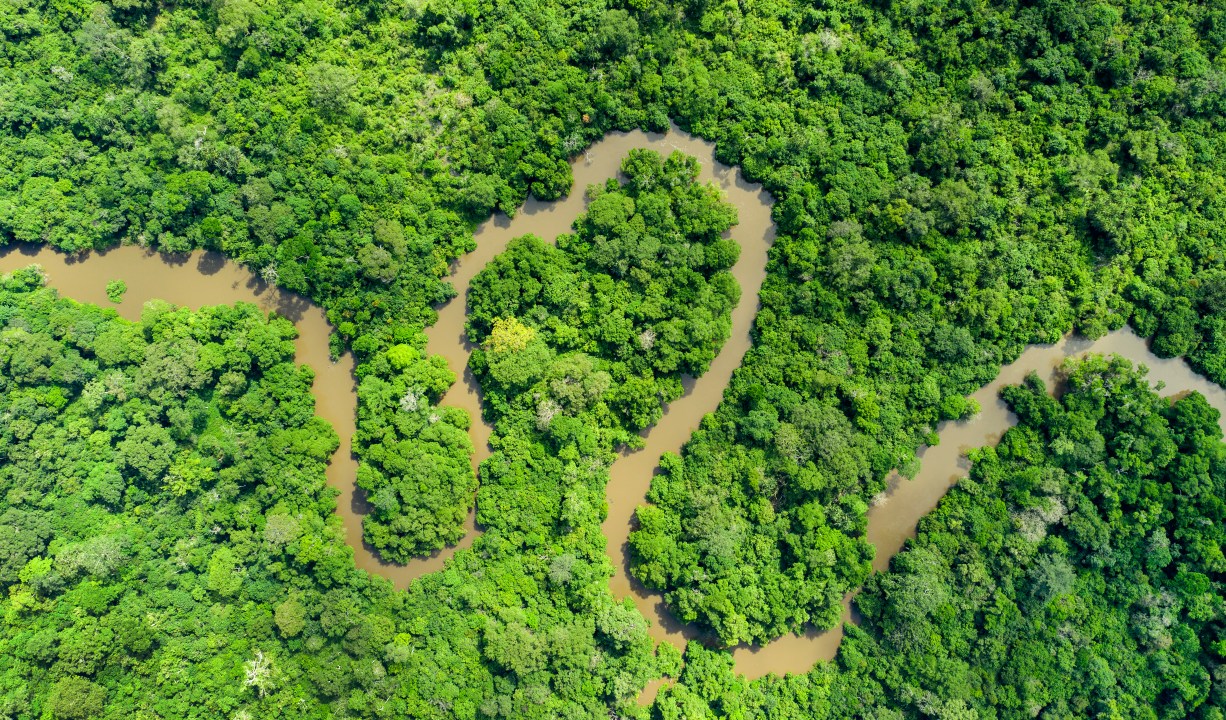
Taking on Zaire ebolavirus
How science and innovation fuel our efforts to help combat a rare but potentially deadly disease
Next: Taking on Zaire ebolavirus
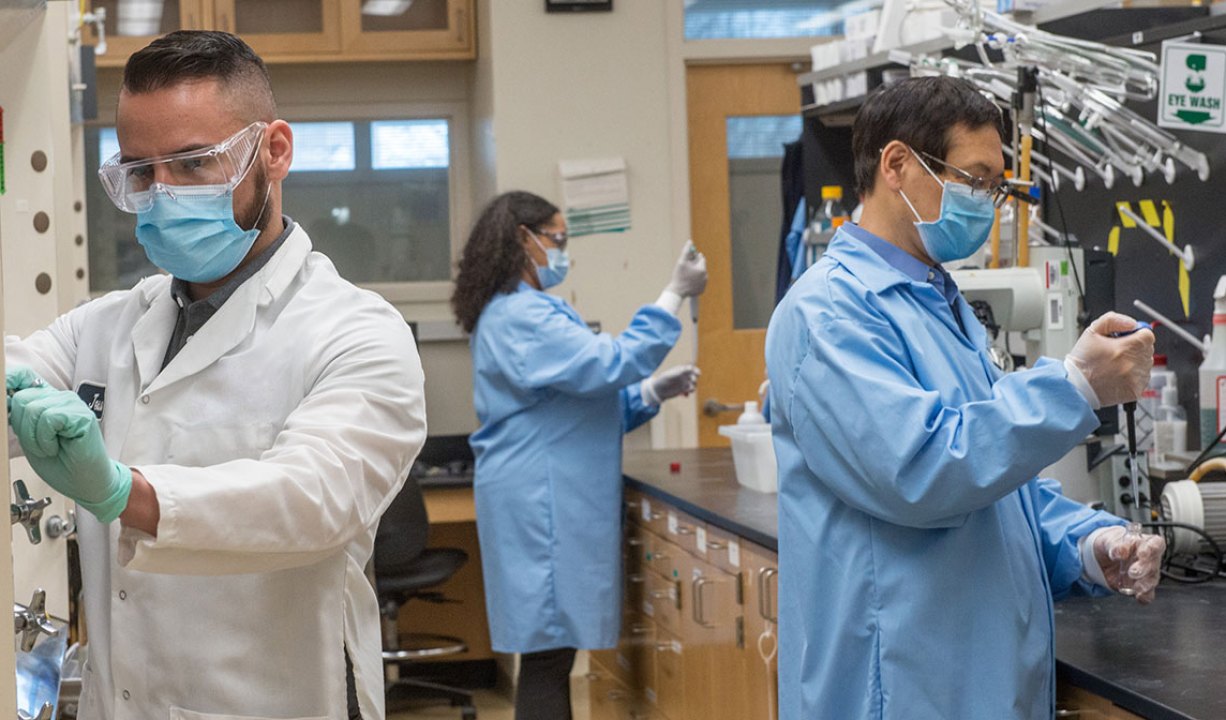
Teaming up with Eisai to help fight cancer
How we're leveraging each other’s unique strengths to help advance cancer research
Next: Teaming up with Eisai to help fight cancer

How Merck scientists are driving next-generation cancer research
Our scientists are accelerating research by looking to improve anti-tumor immune response, targeting specific cancer cells and helping inhibit cancer growth
Next: How Merck scientists are driving next-generation cancer research

In our commitment to R&D, the numbers speak for themselves
We follow the science where we can make the greatest difference
Next: In our commitment to R&D, the numbers speak for themselves
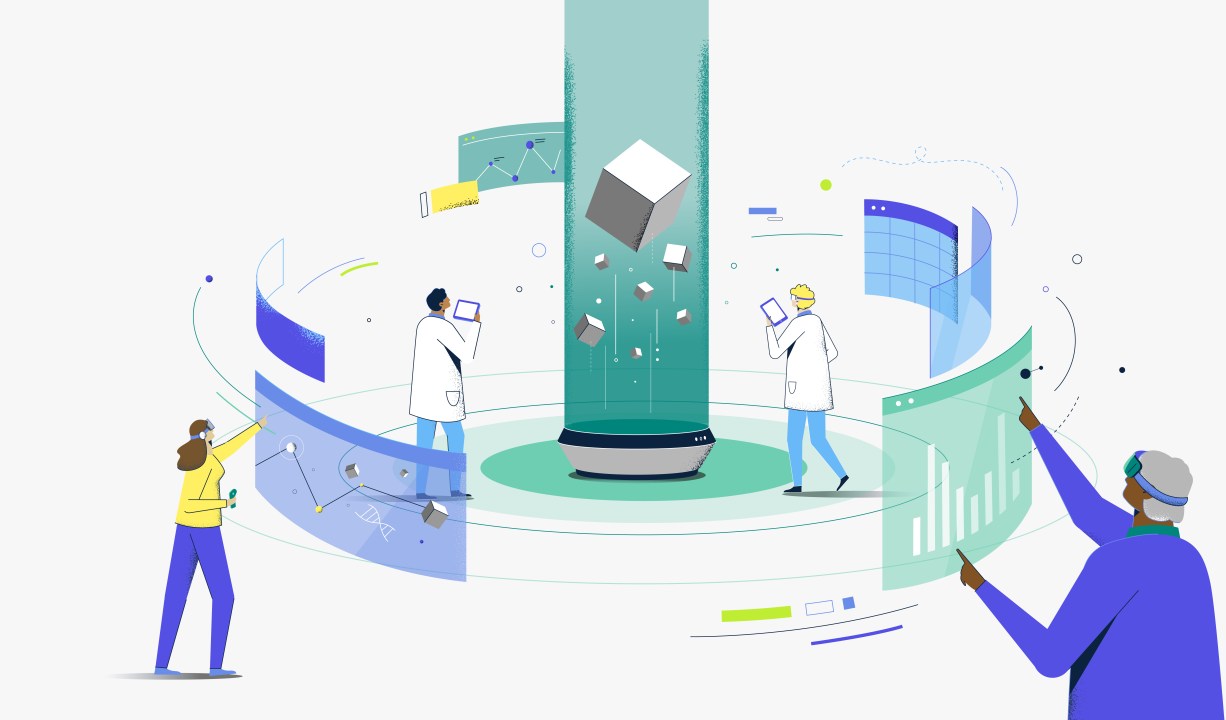
Our Q4 and full-year 2023 earnings report
Merck’s (NYSE: MRK) Q4 and full-year 2023 results reflect sustained growth across oncology and vaccines. Our company announced Q4 worldwide sales of $14.6 billion, an increase of 6% from Q4 2022. Full-year 2023 worldwide sales were $60.1 billion, an increase of 1% from full-year 2022. “2023 was another very strong year for Merck. I am extremely pleased […]
Next: Our Q4 and full-year 2023 earnings report
Safety and quality go hand in hand

Protecting animal health
Our Animal Health business is dedicated to preserving and improving the health, well-being and performance of animals and the people who care for them.
Related links

Business development & licensing
We work with many partners, from early-stage science to clinical-stage programs, to deliver life-changing therapies.

Find our latest financials, events & presentations, news, stock information, and contacts

We aspire to be the premier research-intensive biopharmaceutical company.
Forward-looking statement of Merck & Co., Inc., Rahway, N.J., USA
This website of Merck & Co., Inc., Rahway, N.J., USA (the “company”) includes “forward-looking statements” within the meaning of the safe harbor provisions of the U.S. Private Securities Litigation Reform Act of 1995. These statements are based upon the current beliefs and expectations of the company’s management and are subject to significant risks and uncertainties. There can be no guarantees with respect to pipeline candidates that the candidates will receive the necessary regulatory approvals or that they will prove to be commercially successful. If underlying assumptions prove inaccurate or risks or uncertainties materialize, actual results may differ materially from those set forth in the forward-looking statements. Risks and uncertainties include but are not limited to, general industry conditions and competition; general economic factors, including interest rate and currency exchange rate fluctuations; the impact of pharmaceutical industry regulation and health care legislation in the United States and internationally; global trends toward health care cost containment; technological advances, new products and patents attained by competitors; challenges inherent in new product development, including obtaining regulatory approval; the company’s ability to accurately predict future market conditions; manufacturing difficulties or delays; financial instability of international economies and sovereign risk; dependence on the effectiveness of the company’s patents and other protections for innovative products; and the exposure to litigation, including patent litigation, and/or regulatory actions. The company undertakes no obligation to publicly update any forward-looking statement, whether as a result of new information, future events or otherwise. Additional factors that could cause results to differ materially from those described in the forward-looking statements can be found in the company’s Annual Report on Form 10-K for the year ended December 31, 2023 and the company’s other filings with the Securities and Exchange Commission (SEC) available at the SEC’s Internet site (www.sec.gov). No Duty to Update The information contained in this website was current as of the date presented. The company assumes no duty to update the information to reflect subsequent developments. Consequently, the company will not update the information contained in the website and investors should not rely upon the information as current or accurate after the presentation date.
You are leaving Merck.com
Welcome to merck.com.
By continuing, you will be directed to a site intended only for residents of the United States and Canada. We are called MSD everywhere, except in the United States and Canada where we are known as Merck & Co Inc, Rahway, NJ USA.
An outgrowth of immense investment in scientific research initiated by the U.S. Government during World War II, the National Laboratories have served as the leading institutions for scientific innovation in the United States for more than seventy years.
The Energy Department's 17 National Labs tackle the critical scientific challenges of our time -- from combating climate change to discovering the origins of our universe -- and possess unique instruments and facilities, many of which are found nowhere else in the world. They address large scale, complex research and development challenges with a multidisciplinary approach that places an emphasis on translating basic science to innovation.
Office of Science Laboratories
National nuclear security administration laboratories, other energy department office laboratories.
Learn about 75 National Laboratory breakthroughs that have changed and improved the lives of millions of Americans.
Listen to our Direct Current podcast episode highlighting unique stories from each National Lab!
Learn about the high performance computing resources at the National Labs, which feature some of the fastest supercomputers in the world.
Read the latest 2020 report here.
An official website of the United States government
Here’s how you know
Official websites use .gov A .gov website belongs to an official government organization in the United States.
Secure .gov websites use HTTPS A lock ( Lock Locked padlock icon ) or https:// means you’ve safely connected to the .gov website. Share sensitive information only on official, secure websites.

National Laboratories
The National Laboratories conduct scientific research and development in areas related to energy and technology.
Find an office near you
- Ames Laboratory
- Argonne National Laboratory
- Brookhaven National Laboratory
- Fermi National Accelerator Laboratory
- Frederick National Laboratory for Cancer Research
- Idaho National Laboratory
- Lawrence Berkeley National Laboratory
- Lawrence Livermore National Laboratory
- Los Alamos National Laboratory
- National Energy Technology Laboratory
- National Renewable Energy Laboratory
- Oak Ridge National Laboratory
- Pacific Northwest National Laboratory
- Princeton Plasma Physics Laboratory
- Sandia National Laboratory
- Savannah River National Laboratory
- SLAC National Accelerator Laboratory
- Thomas Jefferson National Accelerator Facility
Have a question?
Ask a real person any government-related question for free. They will get you the answer or let you know where to find it.
By continuing, you will be directed to a site intended only for residents of the United States and Canada. We are called MSD everywhere, except in the United States and Canada where we are known as Merck & Co., Inc., Rahway, NJ, USA.

The link you have selected will take you to a third-party website, owned and operated by AgileOne. Our company does not control, and is not responsible for, the accuracy, content, practices, or standards of the pharmatempjobs.com website and/or AgileOne.

Research & Development
The journey to invention and discovery is guided by science—and inspired by patients, job spotlights in r&d, global clinical trial operations, global medical & scientific affairs, quantitative pharmacology & pharmacometrics, r&d medical doctors & physicians, regulatory affairs, data science & advanced analytics, global project and alliance management (gpam), how we invent for life, our r&d process, purposeful work, cardiovascular, infectious diseases, postdoctoral research fellow program, learn more about our research and development locations, explore all our divisions, join our talent community today..
Receive updates on career opportunities tailored to you.
Connect with us on social
Beware of hiring scams. review our applicant notice ..
- Search Search Please fill out this field.
- What Is R&D?
- Understanding R&D
- Types of R&D
- Pros and Cons
- Considerations
- R&D vs. Applied Research
- Who Spends the Most?
The Bottom Line
- Business Essentials
Research and Development (R&D) Definition, Types, and Importance
:max_bytes(150000):strip_icc():format(webp)/wk_headshot_aug_2018_02__william_kenton-5bfc261446e0fb005118afc9.jpg)
Investopedia / Ellen Lindner
What Is Research and Development (R&D)?
The term research and development (R&D) is used to describe a series of activities that companies undertake to innovate and introduce new products and services. R&D is often the first stage in the development process. Companies require knowledge, talent, and investment in order to further their R&D needs and goals. The purpose of research and development is generally to take new products and services to market and add to the company's bottom line .
Key Takeaways
- Research and development represents the activities companies undertake to innovate and introduce new products and services or to improve their existing offerings.
- R&D allows a company to stay ahead of its competition by catering to new wants or needs in the market.
- Companies in different sectors and industries conduct R&D—pharmaceuticals, semiconductors, and technology companies generally spend the most.
- R&D is often a broad approach to exploratory advancement, while applied research is more geared towards researching a more narrow scope.
- The accounting for treatment for R&D costs can materially impact a company's income statement and balance sheet.
Understanding Research and Development (R&D)
The concept of research and development is widely linked to innovation both in the corporate and government sectors. R&D allows a company to stay ahead of its competition. Without an R&D program, a company may not survive on its own and may have to rely on other ways to innovate such as engaging in mergers and acquisitions (M&A) or partnerships. Through R&D, companies can design new products and improve their existing offerings.
R&D is distinct from most operational activities performed by a corporation. The research and/or development is typically not performed with the expectation of immediate profit. Instead, it is expected to contribute to the long-term profitability of a company. R&D may often allow companies to secure intellectual property, including patents , copyrights, and trademarks as discoveries are made and products created.
Companies that set up and employ departments dedicated entirely to R&D commit substantial capital to the effort. They must estimate the risk-adjusted return on their R&D expenditures, which inevitably involves risk of capital. That's because there is no immediate payoff, and the return on investment (ROI) is uncertain. As more money is invested in R&D, the level of capital risk increases. Other companies may choose to outsource their R&D for a variety of reasons including size and cost.
Companies across all sectors and industries undergo R&D activities. Corporations experience growth through these improvements and the development of new goods and services. Pharmaceuticals, semiconductors , and software/technology companies tend to spend the most on R&D. In Europe, R&D is known as research and technical or technological development.
Many small and mid-sized businesses may choose to outsource their R&D efforts because they don't have the right staff in-house to meet their needs.
Types of R&D
There are several different types of R&D that exist in the corporate world and within government. The type used depends entirely on the entity undertaking it and the results can differ.
Basic Research
There are business incubators and accelerators, where corporations invest in startups and provide funding assistance and guidance to entrepreneurs in the hope that innovations will result that they can use to their benefit.
M&As and partnerships are also forms of R&D as companies join forces to take advantage of other companies' institutional knowledge and talent.
Applied Research
One R&D model is a department staffed primarily by engineers who develop new products —a task that typically involves extensive research. There is no specific goal or application in mind with this model. Instead, the research is done for the sake of research.
Development Research
This model involves a department composed of industrial scientists or researchers, all of who are tasked with applied research in technical, scientific, or industrial fields. This model facilitates the development of future products or the improvement of current products and/or operating procedures.
$42.7 billion of research and development costs later, Amazon was granted 2,244 new patents in 2020. Their patents included advancements in artificial intelligence, machine learning, and cloud computing.
Advantages and Disadvantages of R&D
There are several key benefits to research and development. It facilitates innovation, allowing companies to improve existing products and services or by letting them develop new ones to bring to the market.
Because R&D also is a key component of innovation, it requires a greater degree of skill from employees who take part. This allows companies to expand their talent pool, which often comes with special skill sets.
The advantages go beyond corporations. Consumers stand to benefit from R&D because it gives them better, high-quality products and services as well as a wider range of options. Corporations can, therefore, rely on consumers to remain loyal to their brands. It also helps drive productivity and economic growth.
Disadvantages
One of the major drawbacks to R&D is the cost. First, there is the financial expense as it requires a significant investment of cash upfront. This can include setting up a separate R&D department, hiring talent, and product and service testing, among others.
Innovation doesn't happen overnight so there is also a time factor to consider. This means that it takes a lot of time to bring products and services to market from conception to production to delivery.
Because it does take time to go from concept to product, companies stand the risk of being at the mercy of changing market trends . So what they thought may be a great seller at one time may reach the market too late and not fly off the shelves once it's ready.
Facilitates innovation
Improved or new products and services
Expands knowledge and talent pool
Increased consumer choice and brand loyalty
Economic driver
Financial investment
Shifting market trends
R&D Accounting
R&D may be beneficial to a company's bottom line, but it is considered an expense . After all, companies spend substantial amounts on research and trying to develop new products and services. As such, these expenses are often reported for accounting purposes on the income statement and do not carry long-term value.
There are certain situations where R&D costs are capitalized and reported on the balance sheet. Some examples include but are not limited to:
- Materials, fixed assets, or other assets have alternative future uses with an estimable value and useful life.
- Software that can be converted or applied elsewhere in the company to have a useful life beyond a specific single R&D project.
- Indirect costs or overhead expenses allocated between projects.
- R&D purchased from a third party that is accompanied by intangible value. That intangible asset may be recorded as a separate balance sheet asset.
R&D Considerations
Before taking on the task of research and development, it's important for companies and governments to consider some of the key factors associated with it. Some of the most notable considerations are:
- Objectives and Outcome: One of the most important factors to consider is the intended goals of the R&D project. Is it to innovate and fill a need for certain products that aren't being sold? Or is it to make improvements on existing ones? Whatever the reason, it's always important to note that there should be some flexibility as things can change over time.
- Timing: R&D requires a lot of time. This involves reviewing the market to see where there may be a lack of certain products and services or finding ways to improve on those that are already on the shelves.
- Cost: R&D costs a great deal of money, especially when it comes to the upfront costs. And there may be higher costs associated with the conception and production of new products rather than updating existing ones.
- Risks: As with any venture, R&D does come with risks. R&D doesn't come with any guarantees, no matter the time and money that goes into it. This means that companies and governments may sacrifice their ROI if the end product isn't successful.
Research and Development vs. Applied Research
Basic research is aimed at a fuller, more complete understanding of the fundamental aspects of a concept or phenomenon. This understanding is generally the first step in R&D. These activities provide a basis of information without directed applications toward products, policies, or operational processes .
Applied research entails the activities used to gain knowledge with a specific goal in mind. The activities may be to determine and develop new products, policies, or operational processes. While basic research is time-consuming, applied research is painstaking and more costly because of its detailed and complex nature.
Who Spends the Most on R&D?
Companies spend billions of dollars on R&D to produce the newest, most sought-after products. According to public company filings, these companies incurred the highest research and development spending in 2020:
- Amazon: $42.7 billion
- Alphabet.: $27.6 billion
- Huawei: $22.0 billion
- Microsoft: $19.3 billion
- Apple: $18.8 billion
- Samsung: $18.8 billion
- Facebook: $18.5 billion
What Types of Activities Can Be Found in Research and Development?
Research and development activities focus on the innovation of new products or services in a company. Among the primary purposes of R&D activities is for a company to remain competitive as it produces products that advance and elevate its current product line. Since R&D typically operates on a longer-term horizon, its activities are not anticipated to generate immediate returns. However, in time, R&D projects may lead to patents, trademarks, or breakthrough discoveries with lasting benefits to the company.
What Is an Example of Research and Development?
Alphabet allocated over $16 billion annually to R&D in 2018. Under its R&D arm X, the moonshot factory, it has developed Waymo self-driving cars. Meanwhile, Amazon has spent even more on R&D projects, with key developments in cloud computing and its cashier-less store Amazon Go. At the same time, R&D can take the approach of a merger & acquisition, where a company will leverage the talent and intel of another company to create a competitive edge. The same can be said with company investment in accelerators and incubators, whose developments it could later leverage.
Why Is Research and Development Important?
Given the rapid rate of technological advancement, R&D is important for companies to stay competitive. Specifically, R&D allows companies to create products that are difficult for their competitors to replicate. Meanwhile, R&D efforts can lead to improved productivity that helps increase margins, further creating an edge in outpacing competitors. From a broader perspective, R&D can allow a company to stay ahead of the curve, anticipating customer demands or trends.
There are many things companies can do in order to advance in their industries and the overall market. Research and development is just one way they can set themselves apart from their competition. It opens up the potential for innovation and increasing sales. But it does come with some drawbacks—the most obvious being the financial cost and the time it takes to innovate.
NASDAQ. " Which Companies Spend the Most in Research and Development (R&D)? "
Strategy+Business. " WHAT THE TOP INNOVATORS GET RIGHT ."
:max_bytes(150000):strip_icc():format(webp)/research_pharma-5bfc322b46e0fb0051bf11a0.jpg)
- Terms of Service
- Editorial Policy
- Privacy Policy
- Your Privacy Choices

An official website of the United States government
Here’s how you know
Official websites use .gov A .gov website belongs to an official government organization in the United States.
Secure .gov websites use HTTPS A lock ( Lock A locked padlock ) or https:// means you’ve safely connected to the .gov website. Share sensitive information only on official, secure websites.
JavaScript appears to be disabled on this computer. Please click here to see any active alerts .
Office of Research and Development (ORD) Laboratories
EPA’s Office of Research and Development Laboratories develop knowledge, assessments, and scientific tools that underpin decisions about EPA’s protective standards, risk assessments, and risk management decisions.
- Center for Environmental Measurement and Modeling
- Center for Computational Toxicology and Exposure
- Center for Public Health and Environmental Assessment
- Center for Environmental Solutions and Emergency Response
- EPA Laboratory Enterprise Home
- Program Laboratories
- Regional Laboratories
- ORD Laboratories
- Environmental Methods
- Cross-Agency Laboratory Activities
- National Program Manager Activities

- Design Objectives
- Building Types
- Space Types
- Design Disciplines
- Guides & Specifications
- Resource Pages
- Project Management
- Building Commissioning
- Operations & Maintenance
- Building Information Modeling (BIM)
- Unified Facilities Guide Specifications (UFGS)
- Unified Facilities Criteria (UFC)
- VA Master Specifications (PG-18-1)
- Design Manuals (PG-18-10)
- Department of Energy
- General Services Administration
- Department of Homeland Security
- Department of State
- Course Catalog
- Workforce Development
- Case Studies
- Codes & Standards
- Industry Organizations
Research Laboratory
by Daniel Watch and Deepa Tolat Perkins + Will
Within This Page
Building attributes, emerging issues, relevant codes and standards, additional resources.
Research Laboratories are workplaces for the conduct of scientific research. This WBDG Building Type page will summarize the key architectural, engineering, operational, safety, and sustainability considerations for the design of Research Laboratories.
The authors recognize that in the 21st century clients are pushing project design teams to create research laboratories that are responsive to current and future needs, that encourage interaction among scientists from various disciplines, that help recruit and retain qualified scientists, and that facilitates partnerships and development. As such, a separate WBDG Resource Page on Trends in Lab Design has been developed to elaborate on this emerging model of laboratory design.
A. Architectural Considerations
Over the past 30 years, architects, engineers, facility managers, and researchers have refined the design of typical wet and dry labs to a very high level. The following identifies the best solutions in designing a typical lab.
Lab Planning Module
The laboratory module is the key unit in any lab facility. When designed correctly, a lab module will fully coordinate all the architectural and engineering systems. A well-designed modular plan will provide the following benefits:
Flexibility —The lab module, as Jonas Salk explained, should "encourage change" within the building. Research is changing all the time, and buildings must allow for reasonable change. Many private research companies make physical changes to an average of 25% of their labs each year. Most academic institutions annually change the layout of 5 to 10% of their labs. See also WBDG Productive—Design for the Changing Workplace .
- Expansion —The use of lab planning modules allows the building to adapt easily to needed expansions or contractions without sacrificing facility functionality.
A common laboratory module has a width of approximately 10 ft. 6 in. but will vary in depth from 20–30 ft. The depth is based on the size necessary for the lab and the cost-effectiveness of the structural system. The 10 ft. 6 in. dimension is based on two rows of casework and equipment (each row 2 ft. 6 in. deep) on each wall, a 5 ft. aisle, and 6 in. for the wall thickness that separates one lab from another. The 5 ft. aisle width should be considered a minimum because of the requirements of the Americans with Disabilities Act (ADA) .
Two-Directional Lab Module —Another level of flexibility can be achieved by designing a lab module that works in both directions. This allows the casework to be organized in either direction. This concept is more flexible than the basic lab module concept but may require more space. The use of a two-directional grid is beneficial to accommodate different lengths of run for casework. The casework may have to be moved to create a different type or size of workstation.
Three-Dimensional Lab Module —The three-dimensional lab module planning concept combines the basic lab module or a two-directional lab module with any lab corridor arrangement for each floor of a building. This means that a three-dimensional lab module can have a single-corridor arrangement on one floor, a two-corridor layout on another, and so on. To create a three-dimensional lab module:
- A basic or two-directional lab module must be defined.
- All vertical risers must be fully coordinated. (Vertical risers include fire stairs, elevators, restrooms, and shafts for utilities.)
- The mechanical, electrical, and plumbing systems must be coordinated in the ceiling to work with the multiple corridor arrangements.
Lab Planning Concepts
The relationship of the labs, offices, and corridor will have a significant impact on the image and operations of the building. See also WBDG Functional—Account for Functional Needs .
Do the end users want a view from their labs to the exterior, or will the labs be located on the interior, with wall space used for casework and equipment?
Some researchers do not want or cannot have natural light in their research spaces. Special instruments and equipment, such as nuclear magnetic resonance (NMR) apparatus, electron microscopes, and lasers cannot function properly in natural light. Natural daylight is not desired in vivarium facilities or in some support spaces, so these are located in the interior of the building.
Zoning the building between lab and non-lab spaces will reduce costs. Labs require 100% outside air while non-lab spaces can be designed with re-circulated air, like an office building .
Adjacencies with corridors can be organized with a single, two corridor (racetrack), or a three corridor scheme. There are number of variations to organize each type. Illustrated below are three ways to organize a single corridor scheme:
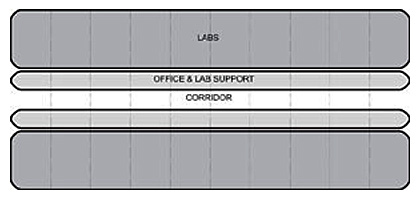
Single corridor lab design with labs and office adjacent to each other.
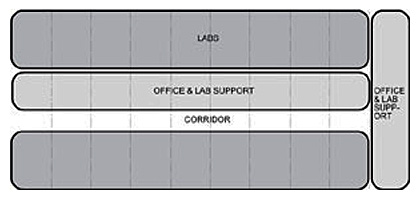
Single corridor lab design with offices clustered together at the end and in the middle.
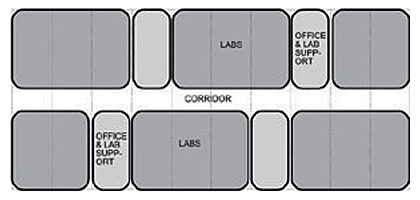
Single corridor lab design with office clusters accessing main labs directly.
- Open labs vs. closed labs. An increasing number of research institutions are creating "open" labs to support team-based work. The open lab concept is significantly different from that of the "closed" lab of the past, which was based on accommodating the individual principle investigator. In open labs, researchers share not only the space itself but also equipment, bench space, and support staff. The open lab format facilitates communication between scientists and makes the lab more easily adaptable for future needs. A wide variety of labs—from wet biology and chemistry labs, to engineering labs, to dry computer science facilities—are now being designed as open labs.

Flexibility
In today's lab, the ability to expand, reconfigure, and permit multiple uses has become a key concern. The following should be considered to achieve this:
Flexible Lab Interiors
Equipment zones—These should be created in the initial design to accommodate equipment, fixed, or movable casework at a later date.
Generic labs
Mobile casework—This can be comprised of mobile tables and mobile base cabinets. It allows researchers to configure and fit out the lab based on their needs as opposed to adjusting to pre-determined fixed casework.
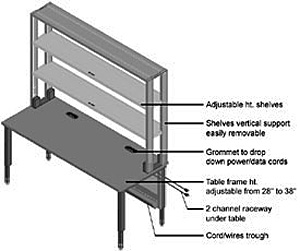
Mobile casework
Mobile base cabinet Photo Credit: Kewaunee Scientific Corp.
Flexible partitions—These can be taken down and put back up in another location, allowing lab spaces to be configured in a variety of sizes.
Overhead service carriers—These are hung from the ceiling. They can have utilities like piping, electric, data, light fixtures, and snorkel exhausts. They afford maximum flexibility as services are lifted off the floor, allowing free floor space to be configured as needed.
Flexible Engineering Systems
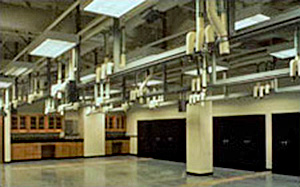
Lab designed with overhead connects and disconnects allow for flexibility and fast hook up of equipment.
Labs should have easy connects/disconnects at walls and ceilings to allow for fast and affordable hook up of equipment. See also WBDG Productive—Integrate Technological Tools .
The Engineering systems should be designed such that fume hoods can be added or removed.
Space should be allowed in the utility corridors, ceilings, and vertical chases for future HVAC, plumbing, and electric needs.
Building Systems Distribution Concepts
Interstitial space.
An interstitial space is a separate floor located above each lab floor. All services and utilities are located here where they drop down to service the lab below. This system has a high initial cost but it allows the building to accommodate change very easily without interrupting the labs.
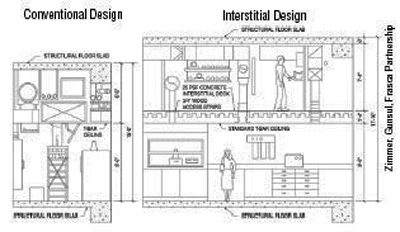
Conventional design vs. interstitial design Image Credit: Zimmer, Gunsul, Frasca Partnership
Service Corridor
Lab spaces adjoin a centrally located corridor where all utility services are located. Maintenance personnel are afforded constant access to main ducts, shutoff valves, and electric panel boxes without having to enter the lab. This service corridor can be doubled up as an equipment/utility corridor where common lab equipment like autoclaves, freezer rooms, etc. can be located.
B. Engineering Considerations
Typically, more than 50% of the construction cost of a laboratory building is attributed to engineering systems. Hence, the close coordination of these ensures a flexible and successfully operating lab facility. The following engineering issues are discussed here: structural systems, mechanical systems, electrical systems, and piping systems. See also WBDG Functional—Ensure Appropriate Product/Systems Integration .
Structural Systems
Once the basic lab module is determined, the structural grid should be evaluated. In most cases, the structural grid equals 2 basic lab modules. If the typical module is 10 ft. 6 in. x 30 ft., the structural grid would be 21 ft. x 30 ft. A good rule of thumb is to add the two dimensions of the structural grid; if the sum equals a number in the low 50's, then the structural grid would be efficient and cost-effective.
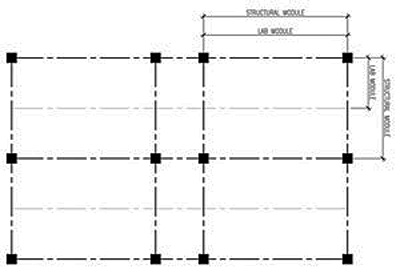
Typical lab structural grid.
Key design issues to consider in evaluating a structural system include:
- Framing depth and effect on floor-to-floor height;
- Ability to coordinate framing with lab modules;
- Ability to create penetrations for lab services in the initial design as well as over the life of the building;
- Potential for vertical or horizontal expansion;
- Vibration criteria; and
Mechanical Systems
The location of main vertical supply/exhaust shafts as well as horizontal ductwork is very crucial in designing a flexible lab. Key issues to consider include: efficiency and flexibility, modular design, initial costs , long-term operational costs , building height and massing , and design image .
The various design options for the mechanical systems are illustrated below:
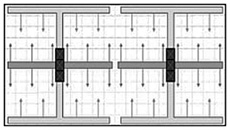
Shafts in the middle of the building
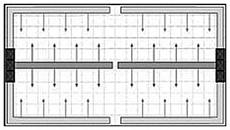
Shafts at the end of the building
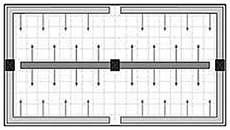
Exhaust at end and supply in the middle

Multiple internal shafts

Shafts on the exterior
See also WBDG High Performance HVAC .
Electrical Systems
Three types of power are generally used for most laboratory projects:
Normal power circuits are connected to the utility supply only, without any backup system. Loads that are typically on normal power include some HVAC equipment, general lighting, and most lab equipment.
Emergency power is created with generators that will back up equipment such as refrigerators, freezers, fume hoods, biological safety cabinets, emergency lighting, exhaust fans, animal facilities, and environmental rooms. Examples of safe and efficient emergency power equipment include distributed energy resources (DER) , microturbines , and fuel cells .
An uninterruptible power supply (UPS) is used for data recording, certain computers, microprocessor-controlled equipment, and possibly the vivarium area. The UPS can be either a central unit or a portable system, such as distributed energy resources (DER) , microturbines , fuel cells , and building integrated photovoltaics (BIPV) .
See also WBDG Productive—Assure Reliable Systems and Spaces .
The following should be considered:
- Load estimation
- Site distribution
- Power quality
- Management of electrical cable trays/panel boxes
- User expectations
- Illumination levels
- Lighting distribution-indirect, direct, combination
- Luminaire location and orientation-lighting parallel to casework and lighting perpendicular to casework
- Telephone and data systems
Piping Systems
There are several key design goals to strive for in designing laboratory piping systems:
- Provide a flexible design that allows for easy renovation and modifications.
- Provide appropriate plumbing systems for each laboratory based on the lab programming.
- Provide systems that minimize energy usage .
- Provide equipment arrangements that minimize downtime in the event of a failure.
- Locate shutoff valves where they are accessible and easily understood.
- Accomplish all of the preceding goals within the construction budget.
C. Operations and Maintenance
Cost savings.
The following cost saving items can be considered without compromising quality and flexibility:
- Separate lab and non-lab zones.
- Try to design with standard building components instead of customized components. See also WBDG Functional—Ensure Appropriate Product/Systems Integration .
- Identify at least three manufacturers of each material or piece of equipment specified to ensure competitive bidding for the work.
- Locate fume hoods on upper floors to minimize ductwork and the cost of moving air through the building.
- Evaluate whether process piping should be handled centrally or locally. In many cases it is more cost-effective to locate gases, in cylinders, at the source in the lab instead of centrally.
- Create equipment zones to minimize the amount of casework necessary in the initial construction.
- Provide space for equipment (e.g., ice machine) that also can be shared with other labs in the entry alcove to the lab. Shared amenities can be more efficient and cost-effective.
- Consider designating instrument rooms as cross-corridors, saving space as well as encouraging researchers to share equipment.
- Design easy-to-maintain, energy-efficient building systems. Expose mechanical, plumbing, and electrical systems for easy maintenance access from the lab.
- Locate all mechanical equipment centrally, either on a lower level of the building or on the penthouse level.
- Stack vertical elements above each other without requiring transfers from floor to floor. Such elements include columns, stairs, mechanical closets, and restrooms.
D. Lab and Personnel Safety and Security
Protecting human health and life is paramount, and safety must always be the first concern in laboratory building design. Security-protecting a facility from unauthorized access-is also of critical importance. Today, research facility designers must work within the dense regulatory environment in order to create safe and productive lab spaces. The WBDG Resource Page on Security and Safety in Laboratories addresses all these related concerns, including:
- Laboratory classifications: dependent on the amount and type of chemicals in the lab;
- Containment devices: fume hoods and bio-safety cabinets;
- Levels of bio-safety containment as a design principle;
- Radiation safety;
- Employee safety: showers, eyewashes, other protective measures; and
- Emergency power.
See also WBDG Secure / Safe Branch , Threat/Vulnerability Assessments and Risk Analysis , Balancing Security/Safety and Sustainability Objectives , Air Decontamination , and Electrical Safety .
E. Sustainability Considerations
The typical laboratory uses far more energy and water per square foot than the typical office building due to intensive ventilation requirements and other health and safety concerns. Therefore, designers should strive to create sustainable , high performance, and low-energy laboratories that will:
- Minimize overall environmental impacts;
- Protect occupant safety ; and
- Optimize whole building efficiency on a life-cycle basis.
For more specific guidance, see WBDG Sustainable Laboratory Design ; EPA and DOE's Laboratories for the 21st Century (Labs21) , a voluntary program dedicated to improving the environmental performance of U.S. laboratories; WBDG Sustainable Branch and Balancing Security/Safety and Sustainability Objectives .
F. Three Laboratory Sectors
There are three research laboratory sectors. They are academic laboratories, government laboratories, and private sector laboratories.
- Academic labs are primarily teaching facilities but also include some research labs that engage in public interest or profit generating research.
- Government labs include those run by federal agencies and those operated by state government do research in the public interest.
- Design of labs for the private sector , run by corporations, is usually driven by the need to enhance the research operation's profit making potential.
G. Example Design and Construction Criteria
For GSA, the unit costs for this building type are based on the construction quality and design features in the following table . This information is based on GSA's benchmark interpretation and could be different for other owners.
LEED® Application Guide for Laboratory Facilities (LEED-AGL)—Because research facilities present a unique challenge for energy efficiency and sustainable design, the U.S. Green Building Council (USGBC) has formed the LEED-AGL Committee to develop a guide that helps project teams apply LEED credits in the design and construction of laboratory facilities. See also the WBDG Resource Page Using LEED on Laboratory Projects .
The following agencies and organizations have developed codes and standards affecting the design of research laboratories. Note that the codes and standards are minimum requirements. Architects, engineers, and consultants should consider exceeding the applicable requirements whenever possible.
- 29 CFR 1910.1450: OSHA "Occupational Exposures to Hazardous Chemicals in Laboratories"
- ANSI/ASSE/AIHA Z9.5 Laboratory Ventilation
- ANSI/ISEA Z358.1 Emergency Eyewash and Shower Equipment
- Association for Assessment and Accreditation of Laboratory Animal Care (AAALAC) Standards
- Biosafety in Microbiological and Biomedical Laboratories (BMBL) 5th Edition , Department of Health and Human Services, Centers for Disease Control and Prevention and National Institutes of Health.
- GSA PBS-P100 Facilities Standards for the Public Buildings Service
- Guidelines for the Laboratory Use of Chemical Carcinogens , Pub. No. 81-2385. National Institutes of Health
- NIH Design Requirements Manual , National Institutes of Health
- NFPA 30 Flammable and Combustible Liquids Code
- NFPA 45 Fire Protection for Laboratories using Chemical
- Unified Facilities Guide Specifications (UFGS) —organized by MasterFormat™ divisions, are for use in specifying construction for the military services. Several UFGS exist for safety-related topics.
Publications
- Building Type Basics for Research Laboratories , 2nd Edition by Daniel Watch. New York: John Wiley & Sons, Inc., 2008. ISBN# 978-0-470-16333-7.
- CRC Handbook of Laboratory Safety , 5th ed. by A. Keith Furr. CRC Press, 2000.
- Design and Planning of Research and Clinical Laboratory Facilities by Leonard Mayer. New York, NY: John Wiley & Sons, Inc., 1995.
- Design for Research: Principals of Laboratory Architecture by Susan Braybrooke. New York, NY: John Wiley & Sons, Inc., 1993.
- Guidelines for Laboratory Design: Health and Safety Considerations , 4th Edition by Louis J. DiBerardinis, et al. New York, NY: John Wiley & Sons, Inc., 2013.
- Guidelines for Planning and Design of Biomedical Research Laboratory Facilities by The American Institute of Architects, Center for Advanced Technology Facilities Design. Washington, DC: The American Institute of Architects, 1999.
- Handbook of Facilities Planning, Vol. 1: Laboratory Facilities by T. Ruys. New York, NY: Van Nostrand Reinhold, 1990.
- Laboratories, A Briefing and Design Guide by Walter Hain. London, UK: E & FN Spon, 1995.
- Laboratory by Earl Walls Associates, May 2000.
- Laboratory Design from the Editors of R&D Magazine.
- Laboratory Design, Construction, and Renovation: Participants, Process, and Product by National Research Council, Committee on Design, Construction, and Renovation of Laboratory Facilities. Washington, DC: National Academy Press, 2000.
- Planning Academic Research Facilities: A Guidebook by National Science Foundation. Washington, DC: National Science Foundation, 1992.
- Research and Development in Industry: 1995-96 by National Science Foundation, Division of Science Resources Studies. Arlington, VA: National Science Foundation, 1998.
- Science and Engineering Research Facilities at Colleges and Universities by National Science Foundation, Division of Science Resources Studies. Arlington, VA, 1998.
- Laboratories for the 21st Century (Labs21) —Sponsored by the U.S. Environmental Protection Agency and the U.S. Department of Energy, Labs21 is a voluntary program dedicated to improving the environmental performance of U.S. laboratories.
WBDG Participating Agencies

National Institute of Building Sciences Innovative Solutions for the Built Environment 1090 Vermont Avenue, NW, Suite 700 | Washington, DC 20005-4950 | (202) 289-7800 © 2024 National Institute of Building Sciences. All rights reserved. Disclaimer
- Biology & Environment
- Clean Energy
- Fusion & Fission
- Physical Sciences
- National Security
- Neutron Science
- Supercomputing
- User Facilities
- Educational Programs
- Procurement
- Small Business Programs
- Leadership Team
- Visiting ORNL
- Fact Sheets
- Virtual Tour
Laboratory Directed Research & Development
Laboratory Directed Research and Development (LDRD) supports cutting-edge research across ORNL. Its objective is to maintain the vitality of the Laboratory, enhance the Laboratory’s ability to address future DOE missions, and stimulate exploration at the forefront of science and technology. The program has three major components: the Director’s R&D Fund, which develops new capabilities in support of the Laboratory’s research initiatives, the Seed Money Fund, which is open to all innovative ideas that have the potential for enhancing the Laboratory’s core scientific and technical disciplines, and the Named Fellowships, open to outstanding doctorate-level candidate scientists and engineers to achieve experience in areas of science and technology of national importance. LDRD projects are led by ORNL research staff members and often involve collaborations with university researchers.
ORNL LDRD Recent Success Stories
The Big Area Additive Manufacturing-CI system was developed by ORNL researchers and Cincinnati Incorporated. BAAM-CI also received an Editor’s Choice award from R&D Magazine.
BAAM-CI, a large-scale additive manufacturing platform, allows arbitrary geometric components to be 3-D printed on a scale 10 times larger than any other commercial system. The system’s screw-extrusion technique also allows the BAAM-CI to deposit material 200 times faster than existing processes.
BAAM-CI is also the first manufacturing project capable of depositing carbon fiber reinforced plastic into printed materials, endowing objects with greater strength and four to seven times the material’s original stiffness. In addition, BAAM-CI remains more energy efficient than traditional manufacturing methods like stamping and blow molding.
Funding for the project was provided by ORNL’s Laboratory Directed Research and Development program and DOE’s Advanced Manufacturing Office.
Hyperion, or Automated Behavior Computation for Compiled Software , was developed by a team of ORNL researchers led by Stacy Prowell.
Hyperion assesses and computes software or malicious behavior with precise mathematics to prevent inappropriate or illegal access to computer systems.
Since adversaries often exploit a system’s unknown behavior to accomplish their goals, Hyperion is constructed with the unique ability to identify and calculate all unknown inputs under all possible circumstances without any examining codes.
A second feature allows Hyperion to capture, share and reuse malware analyst intelligence to detect and eliminate malicious behavior in future scenarios.
Funding for Hyperion was provided by ORNL’s Laboratory Directed Research and Development program, Lockheed Martin, Applied Communication Sciences and DOE’s Cybersecurity for Energy Delivery Services program.
Additional LDRD Success Stories
- V-shaped External Cavity Laser Diode Array, developed by ORNL’s Bo Liu, Yun Liu and Yehuda Braiman (2013)
- Super-hydro-tunable HiPAS Membranes were developed by ORNL (2014)
- iSPM: Intelligent Software for Personalized Modeling of Expert Opinions, Decisions and Errors in Visual Examination Tasks was developed by Georgia Tourassi, Songhua Xu, Hong-Jun Yoon and Sophie Voisin of the Computational Sciences and Engineering Division at ORNL (2014)
- RCSim (Radio Channel Simulator) Software (2012)
- Low-Cost, Lightweight Robotic Hand Based on Additive Manufacturing (2012)
- Broadband Micromechanical Antenna (2012)
- Self-assembled, Ferromagnetic-Insulator Nanocomposites for Ultrahigh-Density Data Storage (2011)
- Telemedical Retinal Image Analysis and Diagnosis (2010)
- Liquid Microjunction Surface Sampling Probe for Mass Spectrometry (2010)
- Sulfur-Carbon Nanocomposite Cathode Material and Additives for Lithium-Sulfur Batteries (2010)
- Ultrasensitive Nanomechanical Transducers Based on Nonlinear Resonance (2010)
- High-Performance, High-Tc Superconducting Wires Enabled via Self-assembly of Non-superconducting Columnar Defects (2010)
- Thermomagnetic processing technology (2009)
Please contact the LDRD Manager at [email protected] if you have questions regarding the ORNL LDRD Program.
Links of Interest
- DOE Order for LDRD
- DOE LDRD Annual Reports
An official website of the United States government
Here's how you know
Official websites use .gov A .gov website belongs to an official government organization in the United States.
Secure .gov websites use HTTPS. A lock ( Lock Locked padlock ) or https:// means you've safely connected to the .gov website. Share sensitive information only on official, secure websites.
Social, Behavioral and Economic Sciences (SBE)
- Social, Behavioral and Economic Sciences (SBE) Home
- Behavioral and Cognitive Sciences (BCS)
- About NCSES
- Explore Data
- Surveys & Analysis
- Schedule of Release Dates
- Corrections
- Social and Economic Sciences (SES)
- SBE Office of Multidisciplinary Activities (SMA)
- Get NCSES Email Updates Get NCSES Email Updates Go
- NCSES RSS Feed What is RSS?
- Contact NCSES
- Research Areas
- Share on Twitter
- Share on Facebook
- Share on LinkedIn
- Send as Email
Master Government List of Federally Funded R&D Centers
Information on this list is current as of February 2024. Changes from the previous edition are noted below; decertified, closed, or renamed FFRDCs are listed in "Historical Notes."
View the Master Government List by grouping or download the list (56 KB)
- Sponsoring agency
- Administrator type
- Activity type
- General Notes
- Historical Notes
- Prior Lists
- Aerospace Federally Funded Research and Development Center Administrator: The Aerospace Corporation Location: El Segundo, CA Sponsor: Department of Defense , Department of the Air Force
- Ames Laboratory Administrator: Iowa State University Location: Ames, IA Sponsor: Department of Energy
- Argonne National Laboratory Administrator: UChicago Argonne, LLC Location: Argonne, IL Sponsor: Department of Energy
- On 1 January 2007, the Argonne National Laboratory acquired a new university administrator (UChicago Argonne, LLC). The previous administrator was the University of Chicago.
- Arroyo Center Administrator: RAND Corp. Location: Santa Monica, CA Sponsor: Department of Defense , Department of the Army
- The following portions of the RAND Corporation are FFRDCs: National Defense Research Institute (formerly Defense/Office of the Joint Chiefs of Staff), Project Air Force, and the Arroyo Center.
- Brookhaven National Laboratory Administrator: Brookhaven Science Associates, LLC Location: Upton, NY Sponsor: Department of Energy
- On 1 March 1998, Brookhaven National Laboratory acquired a new nonprofit administrator (Brookhaven Science Associates, LLC). The previous administrator was a university consortium.
- Center for Advanced Aviation System Development Administrator: MITRE Corp. Location: McLean, VA Sponsor: Department of Transportation , Federal Aviation Administration
- Center for Communications and Computing Administrator: Institute for Defense Analyses Location: Alexandria, VA Sponsor: Department of Defense , National Security Agency/Central Security Service
- Center for Enterprise Modernization Administrator: MITRE Corporation Location: McLean, VA Sponsor: Department of the Treasury , Internal Revenue Service ; Department of Veterans Affairs ; Social Security Administration ; Department of Commerce
- On 26 August 2022 the Department of Commerce was designated a co-sponsor of the Center for Enterprise Modernization (CEM). In July 2018, the Social Security Administration was designated a co-sponsor of the CEM. In 2013, the Department of Treasury assumed primary sponsorship, with the Internal Revenue Service (IRS) having formal delegation to manage, administer, and execute the CEM agreements on behalf of Treasury. On 1 October 2008, the Department of Veterans Affairs was designated a co-sponsor of the CEM. In August 2001, the IRS Federally Funded Research and Development Center was renamed the Center for Enterprise Modernization. In 1998, the IRS established the IRS Federally Funded Research and Development Center.
- Center for Naval Analyses Administrator: The CNA Corporation Location: Arlington, VA Sponsor: Department of Defense , Department of the Navy
- The Center for Naval Analyses relocated from Alexandria, VA, to Arlington, VA, in 2014.
- Center for Nuclear Waste Regulatory Analyses Administrator: Southwest Research Institute Location: San Antonio, TX Sponsor: Nuclear Regulatory Commission
- CMS Alliance to Modernize Healthcare Administrator: MITRE Corp. Location: Baltimore, MD Sponsor: Department of Health and Human Services , Centers for Medicare and Medicaid Services
- On 15 August 2013, the Centers for Medicare and Medicaid Services Federally Funded Research and Development Center changed its name to the CMS Alliance to Modernize Healthcare. On 27 September 2012, the Centers for Medicare and Medicaid Services Federally Funded Research and Development Center was created.
- Fermi National Accelerator Laboratory Administrator: Fermi Research Alliance, LLC Location: Batavia, IL Sponsor: Department of Energy
- On 1 October 2006, the Fermi National Accelerator Laboratory acquired a new university administrator (Fermi Research Alliance, LLC). The previous administrator was Universities Research Association, Inc.
- Frederick National Laboratory for Cancer Research Administrator: Leidos Biomedical Research, Inc. Location: Frederick, MD Sponsor: Department of Health and Human Services , National Institutes of Health
- On 27 September 2013, the Frederick National Laboratory for Cancer Research's administrator changed names from SAIC-Frederick, Inc., a subsidiary of Science Applications International Corp. to Leidos Biomedical Research, Inc. On 28 February 2012, the National Cancer Institute at Frederick (NCI-Frederick) changed its name to the Frederick National Laboratory for Cancer Research. On 26 September 2008, NCI-Frederick acquired a single industrial firm administrator: SAIC-Frederick, Inc., a subsidiary of Science Applications International Corp. The previous administration was conducted under a system of four industrial firm contractors: SAIC-Frederick, Inc., a subsidiary of Science Applications International Corp.; Charles River Laboratories, Inc.; Data Management Services, Inc.; and Wilson Information Services, Inc. In 2001, the name of this FFRDC was changed from Frederick Cancer Research and Development Center to the National Cancer Institute at Frederick.
- Green Bank Observatory Administrator: Associated Universities, Inc. Location: Green Bank, WV Sponsor: National Science Foundation
- On 1 October 2016, Green Bank Observatory was split out from the National Radio Astronomy Observatory; both retained FFRDC status.
- Homeland Security Operational Analysis Center Administrator: RAND Corp. Location: Arlington, VA Sponsor: Department of Homeland Security , Science and Technology Directorate
- In 2019, the Homeland Security Operational Analysis Center relocated from Crystal City, VA, to Pentagon City, VA. On 15 September 2016, the Homeland Security Operational Analysis Center was created.
- Homeland Security Systems Engineering and Development Institute Administrator: MITRE Corp. Location: McLean, VA Sponsor: Department of Homeland Security , Science and Technology Directorate
- On 5 March 2009, the Homeland Security Systems Engineering and Development Institute was created. This new FFRDC together with the Homeland Security Studies and Analysis Institute replaced the Homeland Security Institute.
- Idaho National Laboratory Administrator: Battelle Energy Alliance, LLC Location: Idaho Falls, ID Sponsor: Department of Energy
- On 1 February 2005, the Idaho National Engineering and Environmental Laboratory was renamed the Idaho National Laboratory (INL). At the same time, INL's administrator, Bechtel BWXT Idaho, LLC, was replaced by Battelle Energy Alliance, LLC.
- Jet Propulsion Laboratory Administrator: California Institute of Technology Location: Pasadena, CA Sponsor: National Aeronautics and Space Administration
- Lawrence Berkeley National Laboratory Administrator: University of California Location: Berkeley, CA Sponsor: Department of Energy
- Lawrence Livermore National Laboratory Administrator: Lawrence Livermore National Security, LLC Location: Livermore, CA Sponsor: Department of Energy
- On 1 October 2007, Lawrence Livermore National Laboratory acquired a new industrial firm administrator (Lawrence Livermore National Security, LLC). The previous administrator was the University of California.
- Lincoln Laboratory Administrator: Massachusetts Institute of Technology Location: Lexington, MA Sponsor: Department of Defense , Office of the Under Secretary of Defense for Research and Engineering
- On 1 February 2018, the Office of the Under Secretary of Defense for Acquisition, Technology, and Logistics was split into two offices, the Office of the Under Secretary of Defense for Acquisition and Sustainment and the Office of the Under Secretary of Defense for Research and Engineering. After the split, the Office of the Under Secretary of Defense for Research and Engineering became the sponsor for the Lincoln Laboratory. On 25 April 2011, the Office of the Under Secretary of Defense for Acquisition, Technology and Logistics became the sponsor of the Lincoln Laboratory. The previous sponsor was the Department of the Air Force.
- Los Alamos National Laboratory Administrator: Triad National Security, LLC Location: Los Alamos, NM Sponsor: Department of Energy
- On 9 June 2018, Los Alamos National Laboratory acquired a new industrial firm administration (Triad National Security, LLC). Between June 2006 and June 2018, Los Alamos National Laboratory was administered by Los Alamos National Security, LLC. Prior to June 2006, the administrator was the University of California.
- National Biodefense Analysis and Countermeasures Center Administrator: Battelle National Biodefense Institute Location: Frederick, MD Sponsor: Department of Homeland Security , Science and Technology Directorate
- National Center for Atmospheric Research Administrator: University Corporation for Atmospheric Research Location: Boulder, CO Sponsor: National Science Foundation
- National Cybersecurity Center of Excellence Administrator: MITRE Corp. Location: Rockville, MD Sponsor: Department of Commerce , National Institute of Standards and Technology
- On 19 September 2014, the National Cybersecurity Center of Excellence was created.
- National Defense Research Institute Administrator: RAND Corp. Location: Santa Monica, CA Sponsor: Department of Defense , Office of the Under Secretary of Defense for Acquisition and Sustainment
- On 1 February 2018, the Office of the Under Secretary of Defense for Acquisition, Technology, and Logistics was split into two offices, the Office of the Under Secretary of Defense for Acquisition and Sustainment and the Office of the Under Secretary of Defense for Research and Engineering. After the split, the Office of the Under Secretary of Defense for Acquisition and Sustainment became the sponsor for the National Defense Research Institute. On 25 April 2011, the Office of the Under Secretary of Defense for Acquisition, Technology and Logistics became the sponsor of the National Defense Research Institute. The previous sponsor was the Office of the Secretary of Defense.
- National Radio Astronomy Observatory Administrator: Associated Universities, Inc. Location: Charlottesville, VA Sponsor: National Science Foundation
- National Renewable Energy Laboratory Administrator: Alliance for Sustainable Energy, LLC Location: Golden, CO Sponsor: Department of Energy
- On 29 July 2008, National Renewable Energy Laboratory acquired a new nonprofit administrator (Alliance for Sustainable Energy, LLC).
- National Security Engineering Center Administrator: MITRE Corp. Location: Bedford, MA, and McLean, VA Sponsor: Department of Defense , Office of the Under Secretary of Defense for Research and Engineering
- On 1 February 2018, the Office of the Under Secretary of Defense for Acquisition, Technology, and Logistics was split into two offices, the Office of the Under Secretary of Defense for Acquisition and Sustainment and the Office of the Under Secretary of Defense for Research and Engineering. After the split, the Office of the Under Secretary of Defense for Research and Engineering became the sponsor for the National Security Engineering Center. On 25 April 2011, C3I Federally Funded Research and Development Center changed its name to the National Security Engineering Center, and it changed its sponsor from the Office of the Secretary of Defense to the Office of the Under Secretary of Defense for Acquisition, Technology and Logistics.
- National Solar Observatory Administrator: Association of Universities for Research in Astronomy, Inc. Location: Boulder, CO Sponsor: National Science Foundation
- In 2015, the National Solar Observatory relocated its headquarters from Sunspot, NM to Boulder, CO. On 1 October 2009, the National Solar Observatory split from the National Optical Astronomy Observatory; both retained FFRDC status.
- NSF's National Optical-Infrared Astronomy Research Laboratory Administrator: Association of Universities for Research in Astronomy, Inc. Location: Tucson, AZ Sponsor: National Science Foundation
- On 1 October 2019, the National Optical Astronomy Observatory was renamed NSF's National Optical-Infrared Astronomy Research Laboratory. The new laboratory also incorporates operations of the International Gemini Observatory and the Vera C. Rubin Observatory. On 1 October 2009, the National Solar Observatory split from the National Optical Astronomy Observatory; both retained FFRDC status. Between February 1984 and September 2009, the National Optical Astronomy Observatory included three former FFRDCs: Cerro Tololo Inter-American Observatory, Kitt Peak National Observatory, and the National Solar Observatory (formerly Sacramento Peak Observatory).
- Oak Ridge National Laboratory Administrator: UT-Battelle, LLC Location: Oak Ridge, TN Sponsor: Department of Energy
- On 1 April 2000, Oak Ridge National Laboratory acquired a new nonprofit administrator (UT-Battelle, LLC). The previous administrator was the industrial firm Lockheed Martin Energy Research Corp.
- Pacific Northwest National Laboratory Administrator: Battelle Memorial Institute Location: Richland, WA Sponsor: Department of Energy
- Princeton Plasma Physics Laboratory Administrator: Princeton University Location: Princeton, NJ Sponsor: Department of Energy
- Project Air Force Administrator: RAND Corp. Location: Santa Monica, CA Sponsor: Department of Defense , Department of the Air Force
- Sandia National Laboratories Administrator: National Technology and Engineering Solutions of Sandia, LLC Location: Albuquerque, NM Sponsor: Department of Energy
- On 1 May 2017, Sandia National Laboratories acquired a new administrator (National Technology and Engineering Solutions of Sandia, LLC, a subsidiary of Honeywell International, Inc.). The previous administrator was Sandia Corporation, a subsidiary of Lockheed Martin Corp.
- Savannah River National Laboratory Administrator: Battelle Savannah River Alliance, LLC Location: Aiken, SC Sponsor: Department of Energy
- On 22 December 2020, Savannah River National Laboratory acquired a new nonprofit administrator, Battelle Savannah River Alliance, LLC. The previous administrator, Savannah River Nuclear Solutions, continues to administer the Savannah River Site. On 1 August 2007, Savannah River National Laboratory acquired a new industrial firm administrator (Savannah River Nuclear Solutions, LLC).
- Science and Technology Policy Institute Administrator: Institute for Defense Analyses Location: Washington, DC Sponsor: National Science Foundation
- On 1 December 2003, RAND Corp. was replaced by the Institute for Defense Analyses as the administrator of the Science and Technology Policy Institute.
- SLAC National Accelerator Laboratory Administrator: Stanford University Location: Menlo Park, CA Sponsor: Department of Energy
- On 15 October 2008, the Stanford Linear Accelerator Center was renamed the SLAC National Accelerator Laboratory.
- Software Engineering Institute Administrator: Carnegie Mellon University Location: Pittsburgh, PA Sponsor: Department of Defense , Office of the Under Secretary of Defense for Research and Engineering
- On 1 February 2018, the Office of the Under Secretary of Defense for Acquisition, Technology, and Logistics was split into two offices, the Office of the Under Secretary of Defense for Acquisition and Sustainment and the Office of the Under Secretary of Defense for Research and Engineering. After the split, the Office of the Under Secretary of Defense for Research and Engineering became the sponsor for the Software Engineering Institute. On 25 April 2011, the Office of the Under Secretary of Defense for Acquisition, Technology and Logistics. became the sponsor of the Software Engineering Institute (SEI). The Office of the Secretary of Defense was the sponsor between 28 April 2010 and 24 April 2011. The Department of the Army was the sponsor between December 2004 and 27 April 2010. The Office of the Secretary of Defense was the sponsor between June 1997 and December 2004. The Defense Advanced Research Projects Agency was the sponsor from 1984 to June 1997.
- Systems and Analyses Center Administrator: Institute for Defense Analyses Location: Alexandria, VA Sponsor: Department of Defense , Office of the Under Secretary of Defense for Acquisition and Sustainment
- On 1 February 2018, the Office of the Under Secretary of Defense for Acquisition, Technology, and Logistics was split into two offices, the Office of the Under Secretary of Defense for Acquisition and Sustainment and the Office of the Under Secretary of Defense for Research and Engineering. After the split, the Office of the Under Secretary of Defense for Acquisition and Sustainment became the sponsor for the Systems and Analyses Center. On 11 June 2013, the Studies and Analyses Center changed its name to the Systems and Analyses Center. On 25 April 2011, the Office of the Under Secretary of Defense for Acquisition, Technology and Logistics became the sponsor of the Studies and Analysis Center. The previous sponsor was the Office of the Secretary of Defense.
- Thomas Jefferson National Accelerator Facility Administrator: Jefferson Science Associates, LLC Location: Newport News, VA Sponsor: Department of Energy
Department of Commerce
National institute of standards and technology, department of the air force, department of the army, department of the navy, national security agency/central security service, office of the under secretary of defense for acquisition and sustainment, office of the under secretary of defense for research and engineering, department of energy, centers for medicare and medicaid services, national institutes of health, science and technology directorate, internal revenue service, federal aviation administration, department of veterans affairs, national aeronautics and space administration, national science foundation, nuclear regulatory commission, social security administration.
- Center for Enterprise Modernization Administrator: MITRE Corporation Location: McLean, VA
- National Cybersecurity Center of Excellence Administrator: MITRE Corp. Location: Rockville, MD
Department of Defense
- Aerospace Federally Funded Research and Development Center Administrator: The Aerospace Corporation Location: El Segundo, CA
- Project Air Force Administrator: RAND Corp. Location: Santa Monica, CA
- Arroyo Center Administrator: RAND Corp. Location: Santa Monica, CA
- Center for Naval Analyses Administrator: The CNA Corporation Location: Arlington, VA
- Center for Communications and Computing Administrator: Institute for Defense Analyses Location: Alexandria, VA
- National Defense Research Institute Administrator: RAND Corp. Location: Santa Monica, CA
- Systems and Analyses Center Administrator: Institute for Defense Analyses Location: Alexandria, VA
- Lincoln Laboratory Administrator: Massachusetts Institute of Technology Location: Lexington, MA
- National Security Engineering Center Administrator: MITRE Corp. Location: Bedford, MA, and McLean, VA
- Software Engineering Institute Administrator: Carnegie Mellon University Location: Pittsburgh, PA
- Ames Laboratory Administrator: Iowa State University Location: Ames, IA
- Argonne National Laboratory Administrator: UChicago Argonne, LLC Location: Argonne, IL
- Brookhaven National Laboratory Administrator: Brookhaven Science Associates, LLC Location: Upton, NY
- Fermi National Accelerator Laboratory Administrator: Fermi Research Alliance, LLC Location: Batavia, IL
- Lawrence Berkeley National Laboratory Administrator: University of California Location: Berkeley, CA
- Lawrence Livermore National Laboratory Administrator: Lawrence Livermore National Security, LLC Location: Livermore, CA
- Los Alamos National Laboratory Administrator: Triad National Security, LLC Location: Los Alamos, NM
- National Renewable Energy Laboratory Administrator: Alliance for Sustainable Energy, LLC Location: Golden, CO
- Oak Ridge National Laboratory Administrator: UT-Battelle, LLC Location: Oak Ridge, TN
- Pacific Northwest National Laboratory Administrator: Battelle Memorial Institute Location: Richland, WA
- Princeton Plasma Physics Laboratory Administrator: Princeton University Location: Princeton, NJ
- SLAC National Accelerator Laboratory Administrator: Stanford University Location: Menlo Park, CA
- Sandia National Laboratories Administrator: National Technology and Engineering Solutions of Sandia, LLC Location: Albuquerque, NM
- Savannah River National Laboratory Administrator: Battelle Savannah River Alliance, LLC Location: Aiken, SC
- Thomas Jefferson National Accelerator Facility Administrator: Jefferson Science Associates, LLC Location: Newport News, VA
- Idaho National Laboratory Administrator: Battelle Energy Alliance, LLC Location: Idaho Falls, ID
Department of Health and Human Services
- CMS Alliance to Modernize Healthcare Administrator: MITRE Corp. Location: Baltimore, MD
- Frederick National Laboratory for Cancer Research Administrator: Leidos Biomedical Research, Inc. Location: Frederick, MD
Department of Homeland Security
- Homeland Security Operational Analysis Center Administrator: RAND Corp. Location: Arlington, VA
- Homeland Security Systems Engineering and Development Institute Administrator: MITRE Corp. Location: McLean, VA
- National Biodefense Analysis and Countermeasures Center Administrator: Battelle National Biodefense Institute Location: Frederick, MD
Department of the Treasury
Department of transportation.
- Center for Advanced Aviation System Development Administrator: MITRE Corp. Location: McLean, VA
- Jet Propulsion Laboratory Administrator: California Institute of Technology Location: Pasadena, CA
- Green Bank Observatory Administrator: Associated Universities, Inc. Location: Green Bank, WV
- NSF's National Optical-Infrared Astronomy Research Laboratory Administrator: Association of Universities for Research in Astronomy, Inc. Location: Tucson, AZ
- National Center for Atmospheric Research Administrator: University Corporation for Atmospheric Research Location: Boulder, CO
- National Radio Astronomy Observatory Administrator: Associated Universities, Inc. Location: Charlottesville, VA
- National Solar Observatory Administrator: Association of Universities for Research in Astronomy, Inc. Location: Boulder, CO
- Science and Technology Policy Institute Administrator: Institute for Defense Analyses Location: Washington, DC
- Center for Nuclear Waste Regulatory Analyses Administrator: Southwest Research Institute Location: San Antonio, TX
Industrial Firms
Nonprofit institutions other than universities and colleges, universities and colleges, including university consortia, district of columbia, massachusetts, pennsylvania, south carolina, west virginia, research and development laboratories, study and analysis centers, systems engineering and integration centers, definitions.
The following Department of Defense definitions were used to classify the centers:
Research and development laboratories fill voids where in-house and private sector research and development centers are unable to meet agency core area needs. Specific objectives for these FFRDCs are to: (1) maintain over the long-term a competency in technology areas where the Government cannot rely on in-house or private sector capabilities, and (2) develop and transfer important new technology to the private sector so the Government can benefit from a wider, broader base of expertise. R&D laboratories engage in research programs that emphasize the evolution and demonstration of advanced concepts and technology, and the transfer or transition of technology.
Study and analysis centers deliver independent and objective analyses and advise in core areas important to their sponsors in support of policy development, decision making, alternative approaches, and new ideas on issues of significance.
System engineering and integration centers provide required support in core areas not available from sponsor's in-house technical and engineering capabilities to ensure that complex systems meet operational requirements. The centers assist with the creation and choice of system concepts and architectures, the specification of technical system and subsystem requirements and interfaces, the development and acquisition of system hardware and software, the testing and verification of performance, the integration of new capabilities, and continuous improvement of system operations and logistics. They often play a critical role in assisting their sponsors in technically formulating, initiating, and evaluating programs and activities undertaken by firms in the for-profit sector.
Source of definitions: FFRDC Management Plan , effective May 1, 1996, Department of Defense, Director of Defense Research and Engineering, pp. 2-3.
General Guidelines
National science foundation role in ffrdc administration, data availability.
Federally funded research and development centers (FFRDCs) have evolved from research facilities established to meet the special needs of World War II. Until 1967, the centers were called "federal contract research centers." In that year, the Federal Council for Science and Technology (FCST) set criteria for the newly named "federally funded research and development centers."
The FCST Memorandum of 1 November 1967 included the following:
In general, all of the following criteria should be met by an institutional unit before it is to be included in the category "Federally Funded Research and Development Center."
- (a) Primary activities include one or more of the following: basic research, applied research, development, or management of R&D; specifically excluded are organizations engaged primarily in: routine quality control and testing, routine service activities, production, mapping and surveys, and information dissemination.
- (b) Constitute a separate organizational unit within the parent organization or is organized as a separately incorporated organization.
- (c) Performs actual R&D or R&D management either upon direct request of the Government or under a broad charter from the Government, but in either case under the direct monitorship of the Government.
- (d) Receives its major financial support (70% or more) from the Federal Government, usually from one agency.
- (e) Has or is expected to have a long-term relationship with its sponsoring agency (about five years or more), as evidenced by the specific obligations it and the agency assume. [1]
- (f) Most or all of the facilities are owned or funded for in the contract by the Government.
- (g) Has an average annual budget (operating and capital equipment) of at least $500,000. [2]
In 1984, the Office of Federal Procurement Policy amended the criteria to read as follows:
Effective 1 February 2010, Federal Acquisition Regulations criteria for FFRDCs were updated as follows:
- (2) An FFRDC meets some special long-term research or development need which cannot be met as effectively by existing in-house or contractor resources. FFRDCs enable agencies to use private sector resources to accomplish tasks that are integral to the mission and operation of the sponsoring agency. An FFRDC, in order to discharge its responsibilities to the sponsoring agency, has access, beyond that which is common to the normal contractual relationship, to Government and supplier data, including sensitive and proprietary data, and to employees and installations equipment and real property. The FFRDC is required to conduct its business in a manner befitting its special relationship with the Government, to operate in the public interest with objectivity and independence, to be free from organizational conflicts of interest, and to have full disclosure of its affairs to the sponsoring agency. It is not the Government's intent that an FFRDC use its privileged information or access to installations equipment and real property to compete with the private sector. However, an FFRDC may perform work for other than the sponsoring agency under the Economy Act, or other applicable legislation, when the work is not otherwise available from the private sector.
- (3) FFRDCs are operated, managed, and/or administered by either a university or consortium of universities, other not-for-profit or nonprofit organization, or an industrial firm, as an autonomous organization or as an identifiable separate operating unit of a parent organization.
- (4) Long-term relationships between the Government and FFRDCs are encouraged in order to provide the continuity that will attract high-quality personnel to the FFRDC. This relationship should be of a type to encourage the FFRDC to maintain currency in its field(s) of expertise, maintain its objectivity and independence, preserve its familiarity with the needs of its sponsor(s), and provide a quick response capability. [3]
In 1990, NSF was given new responsibilities under the Federal Acquisition Regulations as recorded in the Federal Register:
"35.017-6 Master list of FFRDCs.
The National Science Foundation (NSF) maintains a master Government list of FFRDCs. Primary sponsors will provide information on each FFRDC, including sponsoring agreements, mission statements, funding data, and type of R&D being performed, to the NSF upon its request for such information." [3]
Thus, NSF maintains the Master Government List of FFRDCs but does not decide which organizations meet the FFRDC criteria. Rather, NSF adds each FFRDC to the list when the head of the sponsoring agency notifies NSF in writing that he or she has approved a new FFRDC. [3]
NSF reports data on FFRDCs annually in the following series: Federal Funds for Research and Development (obligations for R&D and for R&D plant reported by federal agencies) and FFRDC R&D Expenditures (FFRDC-reported data).
NSF also reports data on the demographic characteristics, research fields, and sources of support of postdoctoral researchers (postdocs) employed at FFRDCs in the annual series Postdocs at Federally Funded R&D Centers .
[1] In practice, agencies review their need for each FFRDC at least once every 5 years. The period of performance for FFRDC contracts ranges from 1 to 5 years.
[2] Hornig DF. 1967. Memorandum to members of Federal Council for Science and Technology. Subject: Federally funded research and development centers. Unpublished memorandum from the Federal Council for Science and Technology, Executive Office of the President, Washington DC, 1 November.
[3] General Services Administration. 2017. Federal Acquisition Regulation (FAR). Effective 19 January 2017. http://www.acquisition.gov/?q=browsefar
Decertifications, closures and renaming, and other associated notes.
- by Sponsoring agency
- Analytic Services, Inc. Administrator: ANSER Sponsor: Department of Defense , Department of the Air Force Removed from the Master Government List of FFRDCs in FY 1977.
- Appalachia Educational Laboratory Administrator: National Institute of Education Sponsor: Department of Health, Education and Welfare, Office of Education Phased out as FFRDC at end of FY 1972.
- Applied Physics Laboratory Administrator: Johns Hopkins University Sponsor: Department of Defense , Department of the Navy Removed from the Master Government List of FFRDCs in FY 1978.
- Applied Physics Laboratory Administrator: University of Washington Sponsor: Department of Defense , Department of the Navy Removed from the Master Government List of FFRDCs in FY 1974.
- Applied Research Laboratory Administrator: Pennsylvania State University Sponsor: Department of Defense , Department of the Navy Removed from the Master Government List of FFRDCs in FY 1978.
- Army Mathematics Research Center Administrator: University of Wisconsin Sponsor: Department of Defense , Department of the Army Phased out as FFRDC at end of FY 1970.
- Atomic Bomb Casualty Commission Administrator: National Academy of Sciences Sponsor: Department of Energy/Atomic Energy Commission Phased out as FFRDC in April 1975.
- Bettis Atomic Power Laboratory Administrator: Westinghouse Electric Corp. Sponsor: Department of Energy/Atomic Energy Commission Removed from the Master Government List of FFRDCs in October 1992.
- C3I Federally Funded Research and Development Center Administrator: MITRE Corp. Sponsor: Department of Defense , Office of the Under Secretary of Defense for Acquisitions, Technology and Logistics Renamed the National Security Engineering Center 25 April 2011.
- Cambridge Electron Accelerator Administrator: Harvard University and MIT Sponsor: Department of Energy/Atomic Energy Commission Closed down in 1974.
- Center for Educational Policy Research Administrator: Stanford Research Institute Sponsor: Department of Health, Education and Welfare, Office of Education Phased out as FFRDC at end of FY 1972.
- Center for Enterprise Modernization Administrator: MITRE, Corp. Sponsor: Department of the Treasury , Internal Revenue Service , Department of Veteran Affairs , Social Security Administration , Department of Commerce On 26 August 2022 the Department of Commerce was designated a co-sponsor of the Center for Enterprise Modernization (CEM). In July 2018, the Social Security Administration was designated a co-sponsor for the CEM. In 2013, the Department of the Treasury assumed primary sponsorship, with the Internal Revenue Service (IRS) having formal delegation to manage, administer, and execute the CEM agreements on behalf of Treasury. On 1 October 2008, the Department of Veterans Affairs was designated a co-sponsor of the Center for Enterprise Modernization.
- Center for Research and Development for Learning and Re-Education Administrator: University of Wisconsin Sponsor: Department of Health, Education and Welfare, Office of Education Phased out as FFRDC at end of FY 1972.
- Center for Research and Development in Higher Education Administrator: University of California Sponsor: Department of Health, Education and Welfare, Office of Education Phased out as FFRDC at end of FY 1972.
- Center for Research in Social Systems Administrator: American University Sponsor: Department of Defense , Department of the Army Phased out as FFRDC at end of FY 1970.
- Center for the Advanced Study of Educational Administration Administrator: University of Oregon Sponsor: Department of Health, Education and Welfare, Office of Education Phased out as FFRDC at end of FY 1972.
- Center for the Study of Social Organization of Schools and the Learning Process Administrator: Johns Hopkins University Sponsor: Department of Health, Education and Welfare, Office of Education Phased out as FFRDC at end of FY 1972.
- Center for the Study of the Evaluation of Instructional Programs Administrator: University of California Sponsor: Department of Health, Education and Welfare, Office of Education Phased out as FFRDC at end of FY 1972.
- Center for Urban Education Administrator: National Institute of Education Sponsor: Department of Health, Education and Welfare, Office of Education Phased out as FFRDC at end of FY 1972.
- Central Atlantic Regional Educational Laboratory Administrator: National Institute of Education Sponsor: Department of Health, Education and Welfare, Office of Education Phased out as FFRDC at end of FY 1969.
- Central Midwestern Regional Educational Laboratory Administrator: National Institute of Education Sponsor: Department of Health, Education and Welfare, Office of Education Phased out as FFRDC at end of FY 1972.
- Cerro Tololo Inter-American Observatory Sponsor: National Science Foundation Became part of National Optical Astronomy Observatories in 1984.
- Continuous Electron Beam Accelerator Facility Administrator: Southeastern Universities Research Association, Inc. Sponsor: Department of Energy/Atomic Energy Commission Renamed Thomas Jefferson National Accelerator Facility in May 1996.
- Cooperative Educational Research Laboratory, Inc. Administrator: National Institute of Education Sponsor: Department of Health, Education and Welfare, Office of Education Phased out as FFRDC at end of FY 1969.
- Coordination Center for the National Program in Early Childhood Education Administrator: University of Illinois Sponsor: Department of Health, Education and Welfare, Office of Education Phased out as FFRDC at end of FY 1972.
- Critical Technologies Institute Sponsor: National Science Foundation Renamed the Science and Technology Policy Institute 1 October 1998.
- Eastern Regional Institute for Education Administrator: National Institute of Education Sponsor: Department of Health, Education and Welfare, Office of Education Phased out as FFRDC at end of FY 1972.
- Educational Development Center, Inc. Administrator: National Institute of Education Sponsor: Department of Health, Education and Welfare, Office of Education Phased out as FFRDC at end of FY 1972.
- Electromagnetic Compatibility Analysis Center Administrator: IIT Research Institute Sponsor: Department of Defense , Department of the Air Force Removed from the Master Government List of FFRDCs in FY 1972.
- Energy Technology Engineering Center Administrator: Rockwell International Corp. Sponsor: Department of Energy/Atomic Energy Commission Closed out in November 1995.
- Frederick Cancer Research and Development Center Administrator: Science Applications International Corp.; Charles River Laboratories, Inc.; Data Management Services, Inc.; Wilson Information Services, Inc. Sponsor: Department of Health and Human Services , National Institutes of Health Renamed the National Cancer Institute at Frederick in 2001.
- Green Bank Observatory Administrator: Associated Universities, Inc. Sponsor: National Science Foundation On 1 October 2016, Green Bank Observatory was split out from the National Radio Astronomy Observatory; both retained FFRDC status.
- Hanford Engineering Development Laboratory Administrator: Westinghouse Hanford Co. Sponsor: Department of Energy/Atomic Energy Commission Removed from the Master Government List of FFRDCs in October 1992. Hanford included the Liquid Metal Fast Breeder Reactor program beginning in December 1971.
- Holifield National Laboratory Administrator: Union Carbide Corp. Sponsor: Department of Energy/Atomic Energy Commission Renamed Oak Ridge National Laboratory in 1976.
- Homeland Security Institute Administrator: Analytic Services, Inc. Sponsor: Department of Homeland Security , Science and Technology Directorate The Homeland Security Institute (HSI) was operational from 26 April 2004 to 25 April 2009. On 5 March 2009, the HSI was replaced by two new FFRDCs: the Homeland Security Studies and Analysis Institute and the Homeland Security Systems Engineering Development Institute.
- Homeland Security Studies and Analysis Institute Administrator: Analytic Services, Inc. Sponsor: Department of Homeland Security , Science and Technology Directorate The Homeland Security Systems Engineering Development Institute was operational from 5 March 2009 until it was phased out on 31 October 2016.
- Hudson Laboratories Administrator: Columbia University Sponsor: Department of Defense , Department of the Navy Phased out as FFRDC at end of FY 1969.
- Human Resources Research Office/Organization Administrator: George Washington University Sponsor: Department of Defense , Department of the Army Phased out as FFRDC at end of FY 1972.
- Idaho National Engineering and Environmental Laboratory Administrator: Bechtel BWXT Idaho, LLC Sponsor: Department of Energy/Atomic Energy Commission Renamed Idaho National Laboratory (INL) on 1 February 2005. Also, INL's administrator, Bechtel BWXT Idaho, LLC, was replaced by Battelle Energy Alliance, LLC, in February 2005. As of 1 October 1999, Lockheed Martin was replaced by Bechtel BWXT Idaho, LLC, as the administrator.
- Idaho National Engineering Laboratory Administrator: Lockheed Martin Idaho Technologies Company Sponsor: Department of Energy/Atomic Energy Commission Renamed Idaho National Engineering and Environmental Laboratory in spring 1997.
- Inhalation Technology Research Institute Administrator: Lovelace Institutes Sponsor: Department of Energy/Atomic Energy Commission Removed from the Master Government List of FFRDCs in May 1996.
- Institute for Advanced Technologies Administrator: University of Texas Sponsor: Department of Defense , Department of the Army Phased out as FFRDC November 1993.
- Institute for Defense Analyses Communications and Computing Administrator: Institute for Defense Analyses Sponsor: Department of Defense , National Security Agency/Central Security Service In FY 2009, the name was changed to the Center for Communications and Computing to avoid confusion between the two Department of Defense FFRDCs administered by the Institute for Defense Analyses. Although the Institute for Defense Analyses Communications and Computing has been in existence since 1956, the Department of Defense did not add it to the Master Government List of FFRDCs until October 1995.
- Institute for Defense Analyses Studies and Analyses Administrator: Institute for Defense Analyses Sponsor: Department of Defense , Office of the Secretary of Defense In FY 2009, the name was changed to the Studies and Analysis Center to avoid confusion between the two Department of Defense FFRDCs administered by the Institute for Defense Analyses.
- Internal Revenue Service (IRS) Federally Funded Research and Development Center Administrator: MITRE, Corp. Sponsor: Department of the Treasury , Internal Revenue Service Renamed the Center for Enterprise Modernization August 2001.
- Judiciary Modernization Engineering Center Administrator: MITRE, Corp. Sponsor: United States Courts , Administrative Office of the United States Courts Decertified as FFRDC 31 January 2021
- Kitt Peak National Observatory Sponsor: National Science Foundation Became part of National Optical Astronomy Observatories in 1984.
- Knolls Atomic Power Laboratory Administrator: General Electric Co. Sponsor: Department of Energy/Atomic Energy Commission Removed from the Master Government List of FFRDCs in October 1992.
- Learning Research and Development Center Administrator: University of Pittsburgh Sponsor: Department of Health, Education and Welfare, Office of Education Phased out as FFRDC at end of FY 1972.
- Liquid Metal Engineering Center Administrator: Rockwell International Corp. Sponsor: Department of Energy/Atomic Energy Commission Became Energy Technology Engineering Center in FY 1980.
- Logistics Management Institute Administrator: Logistics Management Institute Sponsor: Department of Defense , Office of the Secretary of Defense Decertified as FFRDC 24 September 1998.
- Michigan-Ohio Regional Educational Laboratory Administrator: National Institute of Education Sponsor: Department of Health, Education and Welfare, Office of Education Phased out as FFRDC at end of FY 1969.
- Mid-Continent Regional Educational Laboratory Administrator: National Institute of Education Sponsor: Department of Health, Education and Welfare, Office of Education Phased out as FFRDC at end of FY 1972.
- Mound Laboratory Administrator: Monsanto Chemical Co. Sponsor: Department of Energy/Atomic Energy Commission Removed from the Master Government List of FFRDCs in FY 1982.
- National Accelerator Laboratory Administrator: Universities Research Association, Inc. Sponsor: Department of Energy/Atomic Energy Commission Renamed Fermi National Accelerator Laboratory 11 May 1974.
- National Astronomy and Ionosphere Center Administrator: Cornell University Sponsor: National Science Foundation Decertified as FFRDC 1 October 2011.
- National Cancer Institute at Frederick Administrator: SAIC-Frederick Inc., a subsidiary of the Science Applications International Corp. Sponsor: Department of Health and Human Services , National Institutes of Health Renamed the Frederick National Laboratory for Cancer Research 28 February 2012.
- National Laboratory for Higher Education Administrator: National Institute of Education Sponsor: Department of Health, Education and Welfare, Office of Education Phased out as FFRDC at end of FY 1972.
- National Optical Astronomy Observatory Administrator: Association of Universities for Research in Astronomy, Inc. Sponsor: National Science Foundation On 1 October 2019, the National Optical Astronomy Observatory was renamed NSF's National Optical-Infrared Astronomy Research Laboratory. The new laboratory also incorporates operations of the International Gemini Observatory and the Vera C. Rubin Observatory. On 1 October 2009, the National Solar Observatory split from the National Optical Astronomy Observatory; both retained FFRDC status. Between February 1984 and September 2009, the National Optical Astronomy Observatory included three former FFRDCs: Cerro Tololo Inter-American Observatory, Kitt Peak National Observatory, and the National Solar Observatory (formerly Sacramento Peak Observatory).
- National Reactor Testing Station Administrator: Aerojet Nuclear Corp. Sponsor: Department of Energy/Atomic Energy Commission Renamed Idaho National Engineering Laboratory in 1974.
- National Solar Observatory/Sacramento Peak Observatory Sponsor: National Science Foundation Became part of National Optical Astronomy Observatories in 1984. On 1 October 2009, the National Solar Observatory split from the National Optical Astronomy Observatory; both retained FFRDC status.
- NCI Frederick Cancer Research and Development Center Administrator: Science Applications International Corp.; Advanced BioScience Laboratories, Inc.; Charles River Laboratories, Inc.; Data Management Services, Inc. Sponsor: Department of Health and Human Services , National Institutes of Health Renamed National Cancer Institute at Frederick in FY 2001.
- Northwest Regional Educational Laboratory Administrator: National Institute of Education Sponsor: Department of Health, Education and Welfare, Office of Education Phased out as FFRDC at end of FY 1972.
- Oak Ridge Institute for Science and Education Administrator: Oak Ridge Associated Universities, Inc. Sponsor: Department of Energy/Atomic Energy Commission Removed from the Master Government List of FFRDCs in February 1999.
- Ordnance Research Laboratory Administrator: Pennsylvania State University Sponsor: Department of Defense , Department of the Navy Renamed Applied Research Laboratory in 1973.
- Policy Research Center Administrator: Syracuse University Research Corporation Sponsor: Department of Health, Education and Welfare, Office of Education Phased out as FFRDC at end of FY 1972.
- Princeton-Pennsylvania Proton Accelerator Administrator: Princeton University and University of Pennsylvania Sponsor: Department of Energy/Atomic Energy Commission Phased out as FFRDC at end of FY 1971.
- Regional Educational Laboratory for the Carolinas and Virginia Administrator: National Institute of Education Sponsor: Department of Health, Education and Welfare, Office of Education Renamed National Laboratory for Higher Education in FY 1971.
- Research Analysis Corporation Administrator: Research Analysis Corporation Sponsor: Department of Defense , Department of the Army Phased out as FFRDC 1 September 1972.
- Research and Development Center in Educational Stimulation Administrator: University of Georgia Sponsor: Department of Health, Education and Welfare, Office of Education Phased out as FFRDC at end of FY 1972.
- Research and Development Center in Teacher Education Administrator: University of Texas Sponsor: Department of Health, Education and Welfare, Office of Education Phased out as FFRDC at end of FY 1972.
- Research for Better Schools, Inc. Administrator: National Institute of Education Sponsor: Department of Health, Education and Welfare, Office of Education Phased out as FFRDC at end of FY 1972.
- Rocky Mountain Regional Educational Laboratory Administrator: National Institute of Education Sponsor: Department of Health, Education and Welfare, Office of Education Phased out as FFRDC at end of FY 1969.
- Savannah River Technology Center Administrator: Westinghouse Savannah River Co. Sponsor: Department of Energy Renamed Savannah River National Laboratory 8 December 2005.
- Solar Energy Research Institute Administrator: Midwest Research Institute Sponsor: Department of Energy/Atomic Energy Commission Renamed National Renewable Energy Laboratory in September 1991.
- South Central Regional Educational Laboratory Corporation Administrator: National Institute of Education Sponsor: Department of Health, Education and Welfare, Office of Education Phased out as FFRDC at end of FY 1969.
- Southeastern Educational Laboratory Administrator: National Institute of Education Sponsor: Department of Health, Education and Welfare, Office of Education Phased out as FFRDC at end of FY 1972.
- Southwest Educational Development Laboratory Administrator: National Institute of Education Sponsor: Department of Health, Education and Welfare, Office of Education Phased out as FFRDC at end of FY 1972.
- Southwest Regional Educational Laboratory Administrator: National Institute of Education Sponsor: Department of Health, Education and Welfare, Office of Education Phased out as FFRDC at end of FY 1972.
- Southwestern Cooperative Educational Laboratory Administrator: National Institute of Education Sponsor: Department of Health, Education and Welfare, Office of Education Phased out as FFRDC at end of FY 1972.
- Space Radiation Effects Laboratory Administrator: College of William and Mary Sponsor: National Aeronautics and Space Administration Removed from the Master Government List of FFRDCs List in FY 1979.
- Stanford Center for Research and Development in Teaching Administrator: Stanford University Sponsor: Department of Health, Education and Welfare, Office of Education Phased out as FFRDC at end of FY 1972.
- Tax Systems Modernization Institute Administrator: IIT Research Institute Sponsor: Department of the Treasury , Internal Revenue Service Replaced by Internal Revenue Service (IRS) Federally Funded Research and Development Center in October 1998.
- The Far West Laboratory for Educational Research and Development. Administrator: National Institute of Education Sponsor: Department of Health, Education and Welfare, Office of Education Phased out as FFRDC at end of FY 1972.
- Upper Midwest Regional Educational Laboratory, Inc. Administrator: National Institute of Education Sponsor: Department of Health, Education and Welfare, Office of Education Phased out as FFRDC at end of FY 1972.
Office of the Secretary of Defense
Office of the under secretary of defense for acquisitions, technology and logistics, department of energy/atomic energy commission, office of education, department of veteran affairs, administrative office of the united states courts.
- Center for Enterprise Modernization Administrator: MITRE, Corp. On 26 August 2022 the Department of Commerce was designated a co-sponsor of the Center for Enterprise Modernization (CEM). In July 2018, the Social Security Administration was designated a co-sponsor for the CEM. In 2013, the Department of the Treasury assumed primary sponsorship, with the Internal Revenue Service (IRS) having formal delegation to manage, administer, and execute the CEM agreements on behalf of Treasury. On 1 October 2008, the Department of Veterans Affairs was designated a co-sponsor of the Center for Enterprise Modernization.
- Analytic Services, Inc. Administrator: ANSER Removed from the Master Government List of FFRDCs in FY 1977.
- Electromagnetic Compatibility Analysis Center Administrator: IIT Research Institute Removed from the Master Government List of FFRDCs in FY 1972.
- Army Mathematics Research Center Administrator: University of Wisconsin Phased out as FFRDC at end of FY 1970.
- Center for Research in Social Systems Administrator: American University Phased out as FFRDC at end of FY 1970.
- Human Resources Research Office/Organization Administrator: George Washington University Phased out as FFRDC at end of FY 1972.
- Institute for Advanced Technologies Administrator: University of Texas Phased out as FFRDC November 1993.
- Research Analysis Corporation Administrator: Research Analysis Corporation Phased out as FFRDC 1 September 1972.
- Applied Physics Laboratory Administrator: Johns Hopkins University Removed from the Master Government List of FFRDCs in FY 1978.
- Applied Physics Laboratory Administrator: University of Washington Removed from the Master Government List of FFRDCs in FY 1974.
- Applied Research Laboratory Administrator: Pennsylvania State University Removed from the Master Government List of FFRDCs in FY 1978.
- Hudson Laboratories Administrator: Columbia University Phased out as FFRDC at end of FY 1969.
- Ordnance Research Laboratory Administrator: Pennsylvania State University Renamed Applied Research Laboratory in 1973.
- Institute for Defense Analyses Communications and Computing Administrator: Institute for Defense Analyses In FY 2009, the name was changed to the Center for Communications and Computing to avoid confusion between the two Department of Defense FFRDCs administered by the Institute for Defense Analyses. Although the Institute for Defense Analyses Communications and Computing has been in existence since 1956, the Department of Defense did not add it to the Master Government List of FFRDCs until October 1995.
- Institute for Defense Analyses Studies and Analyses Administrator: Institute for Defense Analyses In FY 2009, the name was changed to the Studies and Analysis Center to avoid confusion between the two Department of Defense FFRDCs administered by the Institute for Defense Analyses.
- Logistics Management Institute Administrator: Logistics Management Institute Decertified as FFRDC 24 September 1998.
- C3I Federally Funded Research and Development Center Administrator: MITRE Corp. Renamed the National Security Engineering Center 25 April 2011.
- Savannah River Technology Center Administrator: Westinghouse Savannah River Co. Renamed Savannah River National Laboratory 8 December 2005.
- Atomic Bomb Casualty Commission Administrator: National Academy of Sciences Phased out as FFRDC in April 1975.
- Bettis Atomic Power Laboratory Administrator: Westinghouse Electric Corp. Removed from the Master Government List of FFRDCs in October 1992.
- Cambridge Electron Accelerator Administrator: Harvard University and MIT Closed down in 1974.
- Continuous Electron Beam Accelerator Facility Administrator: Southeastern Universities Research Association, Inc. Renamed Thomas Jefferson National Accelerator Facility in May 1996.
- Energy Technology Engineering Center Administrator: Rockwell International Corp. Closed out in November 1995.
- Hanford Engineering Development Laboratory Administrator: Westinghouse Hanford Co. Removed from the Master Government List of FFRDCs in October 1992. Hanford included the Liquid Metal Fast Breeder Reactor program beginning in December 1971.
- Holifield National Laboratory Administrator: Union Carbide Corp. Renamed Oak Ridge National Laboratory in 1976.
- Idaho National Engineering Laboratory Administrator: Lockheed Martin Idaho Technologies Company Renamed Idaho National Engineering and Environmental Laboratory in spring 1997.
- Idaho National Engineering and Environmental Laboratory Administrator: Bechtel BWXT Idaho, LLC Renamed Idaho National Laboratory (INL) on 1 February 2005. Also, INL's administrator, Bechtel BWXT Idaho, LLC, was replaced by Battelle Energy Alliance, LLC, in February 2005. As of 1 October 1999, Lockheed Martin was replaced by Bechtel BWXT Idaho, LLC, as the administrator.
- Inhalation Technology Research Institute Administrator: Lovelace Institutes Removed from the Master Government List of FFRDCs in May 1996.
- Knolls Atomic Power Laboratory Administrator: General Electric Co. Removed from the Master Government List of FFRDCs in October 1992.
- Liquid Metal Engineering Center Administrator: Rockwell International Corp. Became Energy Technology Engineering Center in FY 1980.
- Mound Laboratory Administrator: Monsanto Chemical Co. Removed from the Master Government List of FFRDCs in FY 1982.
- National Accelerator Laboratory Administrator: Universities Research Association, Inc. Renamed Fermi National Accelerator Laboratory 11 May 1974.
- National Reactor Testing Station Administrator: Aerojet Nuclear Corp. Renamed Idaho National Engineering Laboratory in 1974.
- Oak Ridge Institute for Science and Education Administrator: Oak Ridge Associated Universities, Inc. Removed from the Master Government List of FFRDCs in February 1999.
- Princeton-Pennsylvania Proton Accelerator Administrator: Princeton University and University of Pennsylvania Phased out as FFRDC at end of FY 1971.
- Solar Energy Research Institute Administrator: Midwest Research Institute Renamed National Renewable Energy Laboratory in September 1991.
- Frederick Cancer Research and Development Center Administrator: Science Applications International Corp.; Charles River Laboratories, Inc.; Data Management Services, Inc.; Wilson Information Services, Inc. Renamed the National Cancer Institute at Frederick in 2001.
- NCI Frederick Cancer Research and Development Center Administrator: Science Applications International Corp.; Advanced BioScience Laboratories, Inc.; Charles River Laboratories, Inc.; Data Management Services, Inc. Renamed National Cancer Institute at Frederick in FY 2001.
- National Cancer Institute at Frederick Administrator: SAIC-Frederick Inc., a subsidiary of the Science Applications International Corp. Renamed the Frederick National Laboratory for Cancer Research 28 February 2012.
Department of Health, Education and Welfare
- Appalachia Educational Laboratory Administrator: National Institute of Education Phased out as FFRDC at end of FY 1972.
- Center for Educational Policy Research Administrator: Stanford Research Institute Phased out as FFRDC at end of FY 1972.
- Center for Research and Development for Learning and Re-Education Administrator: University of Wisconsin Phased out as FFRDC at end of FY 1972.
- Center for Research and Development in Higher Education Administrator: University of California Phased out as FFRDC at end of FY 1972.
- Center for Urban Education Administrator: National Institute of Education Phased out as FFRDC at end of FY 1972.
- Center for the Advanced Study of Educational Administration Administrator: University of Oregon Phased out as FFRDC at end of FY 1972.
- Center for the Study of Social Organization of Schools and the Learning Process Administrator: Johns Hopkins University Phased out as FFRDC at end of FY 1972.
- Center for the Study of the Evaluation of Instructional Programs Administrator: University of California Phased out as FFRDC at end of FY 1972.
- Central Atlantic Regional Educational Laboratory Administrator: National Institute of Education Phased out as FFRDC at end of FY 1969.
- Central Midwestern Regional Educational Laboratory Administrator: National Institute of Education Phased out as FFRDC at end of FY 1972.
- Cooperative Educational Research Laboratory, Inc. Administrator: National Institute of Education Phased out as FFRDC at end of FY 1969.
- Coordination Center for the National Program in Early Childhood Education Administrator: University of Illinois Phased out as FFRDC at end of FY 1972.
- Eastern Regional Institute for Education Administrator: National Institute of Education Phased out as FFRDC at end of FY 1972.
- Educational Development Center, Inc. Administrator: National Institute of Education Phased out as FFRDC at end of FY 1972.
- Learning Research and Development Center Administrator: University of Pittsburgh Phased out as FFRDC at end of FY 1972.
- Michigan-Ohio Regional Educational Laboratory Administrator: National Institute of Education Phased out as FFRDC at end of FY 1969.
- Mid-Continent Regional Educational Laboratory Administrator: National Institute of Education Phased out as FFRDC at end of FY 1972.
- National Laboratory for Higher Education Administrator: National Institute of Education Phased out as FFRDC at end of FY 1972.
- Northwest Regional Educational Laboratory Administrator: National Institute of Education Phased out as FFRDC at end of FY 1972.
- Policy Research Center Administrator: Syracuse University Research Corporation Phased out as FFRDC at end of FY 1972.
- Regional Educational Laboratory for the Carolinas and Virginia Administrator: National Institute of Education Renamed National Laboratory for Higher Education in FY 1971.
- Research and Development Center in Educational Stimulation Administrator: University of Georgia Phased out as FFRDC at end of FY 1972.
- Research and Development Center in Teacher Education Administrator: University of Texas Phased out as FFRDC at end of FY 1972.
- Research for Better Schools, Inc. Administrator: National Institute of Education Phased out as FFRDC at end of FY 1972.
- Rocky Mountain Regional Educational Laboratory Administrator: National Institute of Education Phased out as FFRDC at end of FY 1969.
- South Central Regional Educational Laboratory Corporation Administrator: National Institute of Education Phased out as FFRDC at end of FY 1969.
- Southeastern Educational Laboratory Administrator: National Institute of Education Phased out as FFRDC at end of FY 1972.
- Southwest Educational Development Laboratory Administrator: National Institute of Education Phased out as FFRDC at end of FY 1972.
- Southwest Regional Educational Laboratory Administrator: National Institute of Education Phased out as FFRDC at end of FY 1972.
- Southwestern Cooperative Educational Laboratory Administrator: National Institute of Education Phased out as FFRDC at end of FY 1972.
- Stanford Center for Research and Development in Teaching Administrator: Stanford University Phased out as FFRDC at end of FY 1972.
- The Far West Laboratory for Educational Research and Development. Administrator: National Institute of Education Phased out as FFRDC at end of FY 1972.
- Upper Midwest Regional Educational Laboratory, Inc. Administrator: National Institute of Education Phased out as FFRDC at end of FY 1972.
- Homeland Security Institute Administrator: Analytic Services, Inc. The Homeland Security Institute (HSI) was operational from 26 April 2004 to 25 April 2009. On 5 March 2009, the HSI was replaced by two new FFRDCs: the Homeland Security Studies and Analysis Institute and the Homeland Security Systems Engineering Development Institute.
- Homeland Security Studies and Analysis Institute Administrator: Analytic Services, Inc. The Homeland Security Systems Engineering Development Institute was operational from 5 March 2009 until it was phased out on 31 October 2016.
- Internal Revenue Service (IRS) Federally Funded Research and Development Center Administrator: MITRE, Corp. Renamed the Center for Enterprise Modernization August 2001.
- Tax Systems Modernization Institute Administrator: IIT Research Institute Replaced by Internal Revenue Service (IRS) Federally Funded Research and Development Center in October 1998.
- Space Radiation Effects Laboratory Administrator: College of William and Mary Removed from the Master Government List of FFRDCs List in FY 1979.
- Cerro Tololo Inter-American Observatory Became part of National Optical Astronomy Observatories in 1984.
- Critical Technologies Institute Renamed the Science and Technology Policy Institute 1 October 1998.
- Green Bank Observatory Administrator: Associated Universities, Inc. On 1 October 2016, Green Bank Observatory was split out from the National Radio Astronomy Observatory; both retained FFRDC status.
- Kitt Peak National Observatory Became part of National Optical Astronomy Observatories in 1984.
- National Astronomy and Ionosphere Center Administrator: Cornell University Decertified as FFRDC 1 October 2011.
- National Optical Astronomy Observatory Administrator: Association of Universities for Research in Astronomy, Inc. On 1 October 2019, the National Optical Astronomy Observatory was renamed NSF's National Optical-Infrared Astronomy Research Laboratory. The new laboratory also incorporates operations of the International Gemini Observatory and the Vera C. Rubin Observatory. On 1 October 2009, the National Solar Observatory split from the National Optical Astronomy Observatory; both retained FFRDC status. Between February 1984 and September 2009, the National Optical Astronomy Observatory included three former FFRDCs: Cerro Tololo Inter-American Observatory, Kitt Peak National Observatory, and the National Solar Observatory (formerly Sacramento Peak Observatory).
- National Solar Observatory/Sacramento Peak Observatory Became part of National Optical Astronomy Observatories in 1984. On 1 October 2009, the National Solar Observatory split from the National Optical Astronomy Observatory; both retained FFRDC status.
United States Courts
- Judiciary Modernization Engineering Center Administrator: MITRE, Corp. Decertified as FFRDC 31 January 2021
- Master Government List of Federally Funded R&D Centers: FY 2024 Other web product | February 20, 2024
- Master Government List of Federally Funded R&D Centers: FY 2023 Other web product | February 17, 2023
- Master Government List of Federally Funded R&D Centers: FY 2022 Other web product | February 16, 2022
- Master Government List of Federally Funded R&D Centers: FY 2021 Other web product | March 4, 2021
- Master Government List of Federally Funded R&D Centers: FY 2020 Other web product | March 23, 2020
- Master Government List of Federally Funded R&D Centers: FY 2019 Other web product | May 3, 2019
- Master Government List of Federally Funded R&D Centers: FY 2018 Other web product | July 31, 2018
- Master Government List of Federally Funded R&D Centers: FY 2017 Other web product | March 30, 2017
- Master Government List of Federally Funded R&D Centers: FY 2016 Other web product | June 23, 2016
- Master Government List of Federally Funded R&D Centers: FY 2015 (A) Other web product | July 10, 2015
- Master Government List of Federally Funded R&D Centers: FY 2014 (A) Other web product | May 28, 2014
- Master Government List of Federally Funded R&D Centers: FY 2013 (A) Other | May 31, 2013
- Master Government List of Federally Funded R&D Centers: FY 2012 (A) Other | July 13, 2012
- Master Government List of Federally Funded R&D Centers: FY 2011 (A) Other | June 22, 2011
- Master Government List of Federally Funded R&D Centers: FY 2010 (A) Other | May 3, 2010
- Master Government List of Federally Funded R&D Centers: FY 2009 (A) Other | SRS 09-402 | August 13, 2009
- Master Government List of Federally Funded R&D Centers (A) Special Reports | NSF 06-316 | May 24, 2006
- Master Government List of Federally Funded Research and Development Centers: FY 2005 (A) Special Reports | NSF 05-306 | March 2, 2005
- Master Government List of Federally Funded R&D Centers: FY 2004 (A) Special Reports | NSF 04-309 | March 25, 2004
- Master Government List of Federally Funded R&D Centers: FY 2003 (A) Special Reports | NSF 03-308 | January 27, 2003
- Annotated List of 36 Federally Funded R&D Centers (FFRDCs): FY 2002 (A) Special Reports | NSF 02-317 | March 24, 2002
- Master Government List of Federally Funded R&D Centers: FY 2002 (A) Special Reports | NSF 02-302 | October 29, 2001
- Annotated List of 36 Federally Funded R&D Centers (FFRDCs): FY 2001 (A) Special Reports | NSF 01-304 | November 22, 2000
- Master Government List of Federally Funded R&D Centers: FY 2001 (A) Special Reports | NSF 01-303 | November 22, 2000
- Master Government List of Federally Funded R&D Centers: FY 2000 (A) Special Reports | NSF 00-305 | December 1, 1999
- Annotated List of Federally Funded R&D Centers (FFRDCs): March 1999 (A) Special Reports | NSF 99-334 | April 21, 1999
- Master Government List of Federally Funded R&D Centers: FY 1999 (A) Special Reports | NSF 99-308 | November 23, 1998
- Annotated List of Federally Funded R&D Centers (FFRDCs): March 1998 (A) Special Reports | NSF 98-310 | March 1, 1998
- Master Government List of Federally Funded R&D Centers: FY 1998 (A) Special Reports | SRS 98-403 | March 1, 1998
- Annotated List of Federally Funded R&D Centers (FFRDCs): November 1996 (A) Special Reports | SRS 97-401 | November 1, 1996
- Master Government List of Federally Funded R&D Centers: FY 1997 (A) Special Reports | SRS 97-402 | November 1, 1996
- Annotated List of Federally Funded R&D Centers: 1995 (A) Special Reports | SRS 96-404 | June 1, 1996
- Master Government List of Federally Funded R&D Centers: FY 1996 (A) Special Reports | SRS 96-403 | May 1, 1996
Can't Find What You Are Looking For?
- Search NCSES to find data and reports or browse the Publication Index .
- See permissions for reuse of NCSES material.
Last Updated: February 2024
- College of Engineering and Engineering Technology
- Experiences
- Laboratories
Microelectronics Research and Development Lab
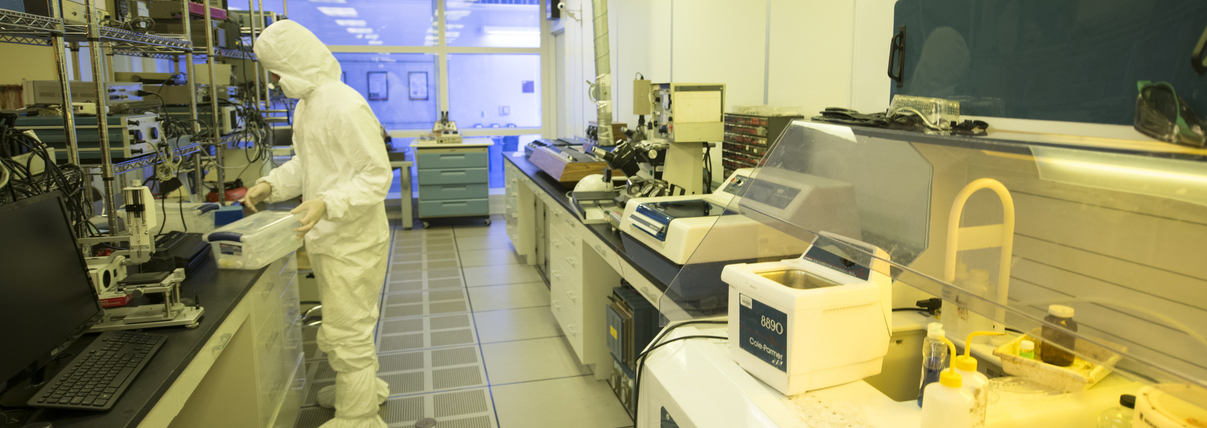
The Microelectronics Research and Development Laboratory (MRDL) is a teaching and research facility specializing in semiconductor and hybrid microelectronic device fabrication. The lab is comprised of 4200 square feet of clean room space separated into six work areas segregated by cleanliness levels required for fabrication equipment and processes. The facility is used for undergraduate and graduate education as well as for faculty, staff and industrial research and development.
Entry to the MRDL requires clean room protocols. Air flow is from ceiling to floor and is laminar. A clean room environment is maintained by removing airborne particulate larger than 0.5 microns (500 nanometers) in size.
The room is maintained at a constant positive air pressure to minimize outside air contamination. Temperature and humidity are controlled.
Yellow lighting is used for safe processing of light-sensitive materials and chemicals. An ultra-pure deionized water system is used for cleaning.
Lab safety systems and policies are monitored to ensure a safe environment. Please review our lab safety guidelines before using the lab.
Work areas:
- 2,500 square feet of Class 100 (ISO Class 5) work area
- 1,750 square feet of Class 1000 (ISO Class 6) work area
- 950 square feet of Class 10000 (ISO Class 7) work area
Class 100 is defined as fewer than 100 airborne particles larger than 0.5 microns per cubic foot of air. Normal particle count in Class 100 areas is less than 10. In outside air, particle counts can range from 500,000 to several million.
Used for thick film screen printing, drying and firing of electrical circuits on ceramic substrates. This is a highly reliable method of electronic circuit fabrication for use in high temperature and robust environments.
Fabrication tools:
- Integrated circuit die attach
- Integrated circuit electrical wire bond connectiing
- Electrical component solder reflow connecting
- Silicon/ceramic wafer dicing
- Laser cutting system
Metrology tools:
- Surface profile measurement of surface roughness and feature thickness
- Video measurement system for determining width, length and height distances
- Die shear and wire bond pull testing
For thin film deposition of multiple materials including conductors, semiconductors and insulators. Materials are accurately deposited in a controlled environment - typically a vacuum chamber with a process gas. The typical thickness is from one to several thousand nanometers.
Thin films are used for electrical device connection, optical components and filters and protective coatings for corrosion and wear. Typical commercial applications include mirrors, sunglasses, cell phone displays, drill bit hardness coatings and solar cells.
- Resistive evaporation
- Electron beam evaporation
- DC magnetron sputtering
- Ion beam sputtering
- Pulsed laser deposition
- White light interferometer (measures film surface roughness and film growth)
- Atomic force microscopy (measures film surface roughness and film growth)
- Electron diffraction system on pulsed laser deposition system (measures growth of crystalline thin film materials)
- Ellipsometry (measures thickness of transparent films)
For fabrication of electronic devices. Fabrication techniques used in this lab include chemical vapor deposition, reactive ion etching, chemical etching and photolithography. Products include semiconductor devices, integrated circuits, sensors, electrical components and solar cells.
- Semiconductor process furnace
- Photolithographic alignment and exposure (single and double sided)
- Photolithographic chemical dispense and process
- Reactive ion etching
- Chemical etching and cleaning
- Transparent thin film measurement system
- Material electrical impedence measurement
- Thin film stress gauge
- Optical microscope
For generation of artwork patterns on a photomask (glass plate) or mylar (plastic) sheet for use in photolithographic processing - using light-sensitive chemicals and ultraviolet lights to create patterns on process parts.
A photomask is a very accurate patterned thin metallic coating on glass defined by opaque and transparent areas. The coating material is typically chromium, which blocks ultraviolet light. Feature sizes can range from 1 micron to thousands of microns
A mylar film is a flexible photographic film used to devine patterns containing opaque and transparent regions. Feature sizes can range from 25 microns to thousands of microns.
- Photomask generation and exposure system
- Laser photoplotter for mylar film fabrication
- Microscopes for critical optical dimensional measurements
- Optical microscopes for inspection
For electronic device and material characterization. In this lab you can test the electrical properties of devices fabricated in the facility and characterize the electrical properties of materials.
- Semiconductor parameter analyzer for current voltage and capacitance voltage measurements
- Probe stations and light-dark boxes
- Radio frequency network analyzer
- Magnetic field test system
- Cryogenic test systems
Industrial Research and Development
The Microelectronics Research and Development Lab is available for industrial research and development. For information about gaining access to the lab and hourly rates, company representatives should contact Venumadhav Korampally, Ph.D.
Engineering Building Room 227
Venumadhav Korampally, Ph.D. Laboratory Director 815-753-9247 [email protected]
- Honors Program
- Mentorship Program
- Professional Development
- Senior Design
- Student Organizations
National Center for Science and Engineering Statistics
- 2022 - 2023
- 2021 - 2022
- 2020 - 2021
- All previous cycle years
The Survey of Federal Funds for Research and Development is an annual census of federal agencies that conduct research and development (R&D) programs and the primary source of information about U.S. federal funding for R&D.
Survey Info
- tag for use when URL is provided --> Methodology
- tag for use when URL is provided --> Data
- tag for use when URL is provided --> Analysis
The Survey of Federal Funds for Research and Development (R&D) is the primary source of information about federal funding for R&D in the United States. The survey is an annual census completed by the federal agencies that conduct R&D programs. Actual data are collected for the fiscal year just completed; estimates are obtained for the current fiscal year.
Areas of Interest
- Government Funding for Science and Engineering
- Research and Development
Survey Administration
Synectics for Management Decisions, Inc. (Synectics) performed the data collection for volume 72 (FYs 2022–23) under contract to the National Center for Science and Engineering Statistics.
Survey Details
- Survey Description (PDF 127 KB)
- Data Tables (PDF 4.8 MB)
Featured Survey Analysis
Federal R&D Obligations Increased 0.4% in FY 2022; Estimated to Decline in FY 2023
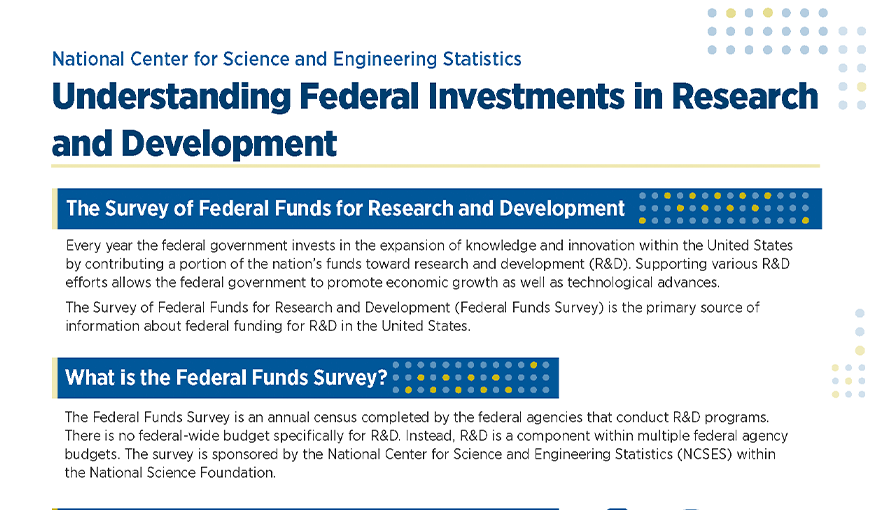
Survey of Federal Funds for R&D Overview
Data highlights, federal agency obligations for research and experimental development (r&d) totaled $190.4 billion in fy 2022.
Although federal obligations for both basic and applied research increased between FY 2021 and FY 2022, experimental development obligations decreased
Methodology
Survey description, survey overview (fys 2022–23 survey cycle; volume 72).
The annual Survey of Federal Funds for Research and Development (Federal Funds for R&D) is the primary source of information about federal funding for R&D in the United States. The results of the survey are also used in the federal government’s calculation of U.S. gross domestic product at the national and state level, used for policy analysis, and used for budget purposes for the Federal Laboratory Consortium for Technology Transfer, the Small Business Innovation Research, and the Small Business Technology Transfer. The survey is sponsored by the National Center for Science and Engineering Statistics (NCSES) within the National Science Foundation (NSF).
Data collection authority
The information is solicited under the authority of the National Science Foundation Act of 1950, as amended, and the America COMPETES Reauthorization Act of 2010.
Major changes to recent survey cycle
Key survey information, initial survey year, reference period.
FYs 2022–23.
Response unit
Federal agencies.
Sample or census
Population size.
The population consists of the 32 federal agencies that conduct R&D programs, excluding the Central Intelligence Agency (CIA).
Sample size
Not applicable; the survey is a census of all federal agencies that conduct R&D programs, excluding the CIA.
Key variables
Key variables of interest are listed below.
The survey provides data on federal obligations by the following key variables:
- Federal agency
- Field of R&D (formerly field of science and engineering)
- Geographic location (within the United States and by foreign country or economy)
- Performer (type of organization doing the work)
- R&D plant (facilities and major equipment)
- Type of R&D (research, development, test, and evaluation [RDT&E] for Department of Defense [DOD] agencies)
- Basic research
- Applied research
- Development, also known as experimental development
The survey provides data on federal outlays by the following key variables:
- R&D (RDT&E for DOD agencies)
R&D plant
Note that the variables “R&D,” “type of R&D,” and “R&D plant” in this survey use definitions comparable to those used by the Office of Management and Budget Circular A-11 , Section 84 (Schedule C).
Survey Design
Target population.
The population consists of the federal agencies that conduct R&D programs, excluding the CIA. For the FYs 2022–23 cycle, a total of 32 federal agencies (14 federal departments and 18 independent agencies) reported R&D data.
Sampling frame
The survey is a census of all federal agencies that conduct R&D programs, excluding the CIA. The agencies are identified from information in the president’s budget submitted to Congress. The Analytical Perspectives volume and the “Detailed Budget Estimates by Agency” section of the appendix to the president’s budget identify agencies that receive funding for R&D.
Sample design
Not applicable.
Data Collection and Processing
Data collection.
Synectics for Management Decisions, Inc. (Synectics) performed the data collection for volume 72 (FYs 2022–23) under contract to NCSES. Agencies were initially contacted by e-mail to verify the contact information of each agency-level survey respondent. A Web-based data collection system is used for the survey. Multiple subdivisions of some federal departments were permitted to submit information to create a complete accounting of the departments’ R&D funding activities.
Data collection for Federal Funds for R&D began in May 2023 and continued into September 2023.
Data processing
A Web-based data collection system is used to collect and manage data for the survey. This Web-based system was designed to help improve survey reporting and reduce data collection and processing costs by offering respondents direct online reporting and editing.
All data collection efforts, data imports, and trend checking are accomplished using the Web-based data collection system. The Web-based data collection system has a component that allows survey respondents to enter their data online; it also has a component that allows the contractor to monitor support requests, data entry, and data issues.
Estimation techniques
Published totals are created by summing respondent data, there are no survey weights or other adjustments.
Survey Quality Measures
Sampling error, coverage error.
Given the existence of a complete list of all eligible agencies, there is no known coverage error. The CIA is purposely excluded.
Nonresponse error
There is no unit nonresponse. To increase item response, agencies are encouraged to estimate when actual data are unavailable. The survey instrument allows respondents to enter data or skip data fields. There are several possible sources of nonresponse error by respondents, including inadvertently skipping data fields or skipping data fields when data are unavailable.
Measurement error
Some measurement problems are known to exist in the Federal Funds of R&D data. Some agencies cannot report the full costs of R&D, the final performer of R&D, or R&D plant data.
For example, DOD does not include headquarters’ costs of planning and administering R&D programs, which are estimated at a fraction of 1% of its total cost. DOD has stated that identification of amounts at this level is impracticable.
The National Institutes of Health (NIH) in the Department of Health and Human Services currently has many of its awards in its financial system without any field of R&D code. Therefore, NIH uses an alternate source to estimate its research dollars by field of R&D. NIH uses scientific class codes (based upon history of grant, content of the title, and the name of the awarding institute or center) as an approximation for field of R&D.
The National Aeronautics and Space Administration (NASA) does not include any field of R&D codes in its financial database. Consequently, NASA must estimate what percentage of the agency’s research dollars are allocated into the fields of R&D.
Also, agencies are required to report the ultimate performer of R&D. However, through past workshops, NCSES has learned that some agencies do not always track their R&D dollars to the ultimate performer of R&D. This leads to some degree of misclassification of performers of R&D, but NCSES has not determined the extent of the errors in performer misclassification by the reporting agencies.
R&D plant data are underreported to some extent because of the difficulty some agencies, particularly DOD and NASA, encounter in identifying and reporting these data. DOD’s respondents report obligations for R&D plant funded under the agency’s appropriation for construction, but they are able to identify only a small portion of the R&D plant support that is within R&D contracts funded from DOD’s appropriation for RDT&E. Similarly, NASA respondents cannot separately identify the portions of industrial R&D contracts that apply to R&D plant because these data are subsumed in the R&D data covering industrial performance. NASA R&D plant data for other performing sectors are reported separately.
Data Availability and Comparability
Data availability.
Annual data are available for FYs 1951–2023.
Data comparability
Until the release of volume 71 (FYs 2021–22) the information included in this survey had been unchanged since volume 23 (FYs 1973–75), when federal obligations for research to universities and colleges by agency and detailed field of science and engineering were added to the survey. Other variables (such as type of R&D and type of performer) are available from the early 1950s on. The volume 71 survey revisions maintained the four main R&D crosscuts (i.e., type of R&D, field of R&D [previously referred to as field of science and engineering], type of performer, and geographic area) collected previously. However, there were revisions within these crosscuts to ensure consistency with other NCSES surveys. These include revisions to the fields of R&D and the type of performer categories (see Technical Notes, table A-3 for a crosswalk of the fields of science and engineering to the fields of R&D). In addition, new variables were added, such as field of R&D for experimental development (whereas before, the survey participants had only reported fields of R&D [formerly fields of science] for basic research and applied research). Grants and contracts for extramural R&D performers and obligations to University Affiliated Research Centers were also added in volume 71.
Every time new data are released, there may be changes to past years’ data because agencies sometimes update older information or reclassify responses for prior years as additional budget data become available. For trend comparisons, use the historical data from only the most recent publication, which incorporates changes agencies have made in prior year data to reflect program reclassifications or other corrections. Do not use data published earlier.
Data Products
Publications.
NCSES publishes data from this survey annually in tables and analytic reports available at Federal Funds for R&D Survey page and in the Science and Engineering State Profiles .
Electronic access
Access to the data for major data elements are available in NCSES’s interactive data tool at https://ncsesdata.nsf.gov/ .
Technical Notes
Survey overview, data collection and processing methods, data comparability (changes), definitions.
Purpose. The annual Survey of Federal Funds for Research and Development (Federal Funds for R&D) is the primary source of information about federal funding for R&D in the United States. The results of the survey are also used in the federal government’s calculation of U.S. gross domestic product at the national and state level, for policy analysis, and for budget purposes for the Federal Laboratory Consortium for Technology Transfer, the Small Business Innovation Research, and the Small Business Technology Transfer. In addition, as of volume 71, the Survey of Federal Science and Engineering Support to Universities, Colleges, and Nonprofit Institutions (Federal S&E Support Survey) was integrated into this survey as a module, making Federal Funds for R&D the comprehensive data source on federal science and engineering (S&E) funding to individual academic and nonprofit institutions.
Data collection authority. The information is solicited under the authority of the National Science Foundation Act of 1950, as amended, and the America COMPETES Reauthorization Act of 2010.
Survey contractor. Synectics for Management Decisions, Inc. (Synectics).
Survey sponsor. The National Center for Science and Engineering Statistics (NCSES) within the National Science Foundation (NSF).
Frequency . Annual.
Initial survey year . 1951.
Reference period . FYs 2022–23.
Response unit. Federal agencies.
Sample or census. Census.
Population size. For the FYs 2022–23 cycle, a total of 32 federal agencies reported R&D data. (See section “ Survey Design ” for details.)
Sample size. Not applicable; the survey is a census of all federal agencies that conduct R&D programs, excluding the Central Intelligence Agency (CIA).
Target population. The population consists of the federal agencies that conduct R&D programs, excluding the CIA. For the FYs 2022–23 cycle, a total of 32 federal agencies (14 federal departments and 18 independent agencies) reported R&D data.
Sampling f rame. The survey is a census of all federal agencies that conduct R&D programs, excluding the CIA. The agencies are identified from information in the president’s budget submitted to Congress. The Analytical Perspectives volume and the “Detailed Budget Estimates by Agency” section of the appendix to the president’s budget identify agencies that receive funding for R&D.
Sample design. Not applicable.
Data collection. Data for FYs 2022–23 (volume 72) were collected by Synectics under contract to NCSES (for a full list of fiscal years canvassed by survey volume reference, see Table A-4 ). Data collection began with an e-mail to each agency to verify the name, phone number, and e-mail address of each agency-level survey respondent. A Web-based data collection system is used for the survey. Because multiple subdivisions of some federal departments completed the survey, there were 72 agency-level respondents: 6 federal departments that reported for themselves, 48 agencies within another 8 federal departments, and 18 independent agencies. However, lower offices could also be authorized to enter data: in Federal Funds for R&D nomenclature, agency-level offices could authorize program offices, program offices could authorize field offices, and field offices could authorize branch offices. When these suboffices are included, there were 725 total respondents: 72 agencies, 95 program offices, 178 field offices, and 380 branch offices.
Since volume 66, each survey cycle collects information for 2 federal government fiscal years: the fiscal year just completed (FY 2022—i.e., 1 October 2021 through 30 September 2022) and the current fiscal year during the start of the survey collection period (i.e., FY 2023). FY 2022 data are completed transactions. FY 2023 data are estimates of congressional appropriation actions and apportionment and reprogramming decisions.
Data collection began on 10 May 2023, and the requested due date for data submissions was 5 August 2023. Data collection was extended until all surveyed agencies provided complete and final survey data in September 2023.
Mode. Federal Funds for R&D uses a Web-based data collection system. The Web-based system consists of a data collection component that allows survey respondents to enter their data online and a monitoring component that allows the data collection contractor to monitor support requests, data entry, and data issues. The Web-based system’s two components are password protected so that only authorized respondents and staff can access them. However, some agencies submit their data in alternative formats such as Excel files, which are later imported into the Web-based system. All edit and trend checks are accomplished through the Web-based system. Final submission occurs through the Web-based system after all edit failures and trend checks have been resolved.
Response rate. The unit response rate is 100%.
Data checking . Data errors in Federal Funds for R&D are flagged automatically by the Web-based data collection system: respondents cannot submit their final data to NCSES until all required fields have been completed without errors. Once data are submitted, specially written SAS programs are run to check each agency’s submission to identify possible discrepancies, to ensure data from all suboffices are included correctly, and to check that there were no inadvertent shifts in reporting from one year to the next. As always, respondents are contacted to resolve potential reporting errors that cannot be reconciled by the narratives. Explanations of questionable data are noted by the survey respondents for NCSES review.
Imputation . None.
Weighting. None.
Variance estimation. Not applicable.
Sampling error. Not applicable.
Coverage error. Given the existence of a complete list of all eligible agencies, there is no known coverage error. The CIA is purposely excluded.
Nonresponse error. There is no unit nonresponse. To increase item response, agencies are encouraged to estimate when actual data are unavailable. The survey instrument allows respondents to enter data or skip data fields; however, blank fields are not accepted for survey submission, and respondents must either populate the fields with data or with $0 if the question is not applicable. There are several possible sources of nonresponse error by respondents, including inadvertently skipping data fields, skipping data fields when data are unavailable, or entering $0 when specific data are unavailable.
Measurement error . Some measurement problems are known to exist in the Federal Funds of R&D data. Some agencies cannot report the full costs of R&D, the final performer of R&D, or R&D plant data.
For example, the Department of Defense (DOD) does not include headquarters’ costs of planning and administering R&D programs, which are estimated at a fraction of 1% of its total cost. DOD has stated that identification of amounts at this level is impracticable.
The National Institutes of Health (NIH) in the Department of Health and Human Services (HHS) currently has many of its awards in its financial system without any field of R&D code. Therefore, NIH uses an alternate source to estimate its research dollars by field of R&D. NIH uses scientific class codes (based upon history of grant, content of the title, and the name of the awarding institute or center) as an approximation for field of R&D.
Agencies are asked to report the ultimate performer of R&D. However, through past workshops, NCSES has learned that some agencies do not always track their R&D dollars to the ultimate performer of R&D. In the case of transfers to other federal agencies, the originating agency often does not have information on the final disposition of funding made by the receiving agency. Therefore, intragovernmental transfers, which are classified as federal intramural funding, may have some degree of extramural performance. This leads to some degree of misclassification of performers of R&D, but NCSES has not determined the extent of the errors in performer misclassification by the reporting agencies.
Differences in agency and NCSES classification of some performers will also lead to some degree of measurement error. For example, although many university research foundations are legally organized as nonprofit organizations and may be classified as such within a reporting agency’s own system of record, NCSES classifies these as component units of higher education. These classification differences may contribute to differences in findings by the Federal Funds for R&D and the Federal S&E Support Survey in federal agency obligations to both higher education and nonprofit institutions.
R&D plant data are underreported to some extent because of the difficulty some agencies, particularly DOD and NASA, encounter in identifying and reporting these data. DOD’s respondents report obligations for R&D plant that are funded under the agency’s appropriation for construction, but they are able to identify only a small portion of the R&D plant support that is within R&D contracts funded from DOD’s appropriation for research, development, testing, and evaluation (RDT&E). Similarly, NASA respondents cannot separately identify the portions of industrial R&D contracts that apply to R&D plant because these data are subsumed in the R&D data covering industrial performance. NASA R&D plant data for other performing sectors are reported separately.
Data revisions. When completing the current year’s survey, agencies naturally revise their estimates for the last year of the previous report—in this case, FY 2022. Sometimes, survey submissions also reflect reappraisals and revisions in classification of various aspects of agencies’ R&D programs; in those instances, NCSES requests that agencies provide revised prior year data to maintain consistency and comparability with the most recent R&D concepts.
For trend comparisons, use the historical data from only the most recent publication, which incorporates changes agencies have made in prior year data to reflect program reclassifications or other corrections. Do not use data published earlier.
Changes in survey coverage and population. This cycle (volume 72, FYs 2022–23), one department, the Department of Homeland Security (DHS), became the agency respondent instead of continuing to delegate that role to its bureaus; one agency was added as a respondent—the Department of Agriculture’s (USDA’s) Natural Resources Conservation Service; one agency, the Department of Transportation’s Maritime Administration, resumed reporting; and two agencies, the Department of Treasury’s Internal Revenue Service (IRS) and the independent agency the Federal Communications Commission, ceased to report.
Changes in questionnaire .
- No changes were made to the questionnaire for volume 72.
- The survey was redesigned for volume 71 (FYs 2021–22). The Federal S&E Support Survey was integrated as the final two questions in the Federal Funds for R&D questionnaire. (NCSES will continue to publish these data separately at https://ncses.nsf.gov/surveys/federal-support-survey/ .)
- Four other new questions were added to the standard and DOD versions of the questionnaire; the questions covered, for the fiscal year just completed (FY 2021), R&D deobligations (Standard and DOD Question 4), nonfederal R&D obligations by type of agreement (Standard Question 10 and DOD Question 11), R&D obligations provided to other federal agencies (Standard Question 11 and DOD Question 12), and R&D and R&D plant obligations to university affiliated research centers (Standard Question 17 and DOD Question 19). One new question added solely to the DOD questionnaire (DOD Question 6) was about obligations for Small Business Innovation Research and Small Business Technology Transfer for the fiscal year just completed and the current fiscal year at the time of collection (i.e., FYs 2021 and 2022). Many of the other survey questions were reorganized and revised.
- For volume 71, some changes were made within the questions for consistency with other NCSES surveys. Among the performer categories, federally funded R&D centers (FFRDCs), which in previous volumes were included among the extramural performers, became one of the intramural performers. Other changes include retitling of certain performer categories, where “industry” was changed to “businesses” and “universities and colleges” was changed to “higher education.”
- For volume 71, “field of R&D” was used instead of the former “field of science and engineering.” The survey started collecting field of R&D information for experimental development obligations; previously, field of R&D information was collected only for research obligations.
- For volume 71, federal obligations for research performed at higher education institutions, by detailed field of R&D was asked of all agencies. Previously these data had only been collected from the Departments of Agriculture, Defense, Energy, HHS, and Homeland Security; NASA; and NSF.
- For volume 71, geographic distribution of R&D obligations was asked of all agencies. Previously, these data had only been collected from the Departments of Agriculture, Commerce, Defense, Energy, HHS, Homeland Security; NASA; and NSF. Agencies are asked to provide the principal location (state or outlying area) of the work performed by the primary contractor, grantee, or intramural organization; assign the obligations to the location of the headquarters of the U.S. primary contractor, grantee, or intramural organization; or, for DOD agencies, list the funds as undistributed for classified funds.
- For volume 71, collection of data on funding type (stimulus and non-stimulus) was limited to Question 5 on type of R&D.
- For volume 71, grants and contracts for extramural R&D performers and obligations to University Affiliated Research Centers were added.
- For volume 70 (FYs 2020–21), agencies were requested to report COVID-19 pandemic-related R&D from the agency’s initial appropriations, as well as from any stimulus funds received from the Coronavirus Aid, Relief, and Economic Security (CARES) Act, plus any other pandemic-related supplemental appropriations. Two tables in the questionnaire were modified to collect the stimulus and non-stimulus amounts separately (tables 1 and 2), and seven tables in the questionnaire (tables 6.1, 6.2, 7.1, 11.1, 11.2, 12.1, and 13.1) were added for respondents to specify stimulus and non-stimulus funding by various categories. The data on stimulus funding is reported in volume 70’s data table 132. The Biomedical Advanced Research and Development Authority accounted for 66% of all COVID-19 R&D in FY 2020; these obligations primarily include transfers to the other agencies to help facilitate execution of contractual awards under Operation Warp Speed.
- For volume 70 (FYs 2020–21), the optional narrative tables that ask for comparisons of the R&D obligations reported in Federal Funds for R&D with corresponding amounts in the Federal S&E Support Survey (standard questionnaire only) were renumbered from tables 6B and 6C to tables 6A and 6B.
- In volumes 68 (FYs 2018–19) and 69 (FYs 2019–20), table 6A, which collected information on federal intramural R&D obligations, was deactivated, and agencies were instructed not to complete it.
- For volumes 66 (FYs 2016–17) and 67 (FYs 2017–18), table 6A (formerly table VI.A) was included, but it was modified so that it no longer collected laboratory names.
- Starting with volume 66 (FYs 2016–17), the survey collects 2 federal government fiscal years—actual data for the fiscal year just completed and estimates for the current fiscal year. Previously, the survey also collected projected obligations for the next fiscal year based on the president’s budget request to Congress. For volume 66, data were collected for only 2 fiscal years due to the delayed FY 2018 budget formulation process. However, after consultation with data users, NCSES determined that the projections were not as useful as the budget authority data presented in the budget request.
- In volume 66, the survey table numbering was changed from Roman numerals I–XI and, for selected agencies, the letters A–E, to Arabic numerals 1–16. The order of tables remained the same.
- In the volume 66 DOD-version of the questionnaire, the definition of major systems development was changed to represent DOD Budget Activities 4 through 6 instead of Budget Activities 4 through 7, and questions relating to funding for Operational Systems Development (Budget Activity 7) were added to the instrument. The survey’s narrative tables 6 and 11 were removed from the DOD-version of the questionnaire.
- For volume 65 (FYs 2015–17), the survey reintroduced table VI.A to collect information on federal intramural R&D obligations, including the names and addresses of all federal laboratories that received federal intramural R&D obligations. The table was included in both the standard and DOD questionnaires.
- For volume 62 (FYs 2012–14), the survey added table VI.A to the standard questionnaire for that volume only to collect information on FY 2012 federal intramural R&D obligations, including the names and addresses of all federal laboratories that received federal intramural R&D obligations.
- In volumes 59 (FYs 2009–11) and 60 (FYs 2010–12), questions relating to funding from the American Recovery and Reinvestment Act of 2009 (ARRA) were added to the data collection instruments. The survey collected separate outlays and obligations for ARRA and non-ARRA sources of funding, by performer and geography for FYs 2009 and 2010.
- Starting with volume 59 (FYs 2009–11), federal funding data were requested in actual dollars (instead of rounded in thousands, as was done through volume 58).
Changes in reporting procedures or classification.
- FY 2022. During the volume 72 cycle (FYs 2022–23), NASA revised its FY 2021 data by field of R&D and performer categories based on improved classification procedures developed during the volume 72 reporting period.
- FY 2021. During the volume 71 cycle (FYs 2021–22), NCSES decided to remove “U.S.” from names like “U.S. Space Force” to conform with other surveys. For Federal Funds for R&D, this change will first appear in the detailed statistical tables.
- FY 2020. For volume 70 (FYs 2020 and 2021), data include obligations from supplemental COVID-19 pandemic-related appropriations (e.g., CARES Act) plus any other pandemic-related supplemental appropriations.
- FY 2020. The Department of Energy’s (DOE’s) Naval Reactor Program reclassified some of its R&D obligations from industry-administered FFRDCs to the industry sector.
- FY 2020. The Department of the Air Force (AF) and the DOE’s Energy Efficiency and Renewable Energy (EERE) partially revised their FY 2019 data. AF revised its operational system development classified program numbers for businesses excluding business or industry-administered FFRDCs, and EERE revised its outlay numbers.
- FY 2019. For volume 69 (FYs 2019–20), FY 2020 preliminary data do not include obligations from supplemental COVID-19 pandemic-related appropriations (e.g., CARES Act).
- FY 2019. The Biomedical Advanced Research and Development Authority began reporting. For volume 69 (FYs 2019–20), it could not submit any geographical data, so its data were reported as undistributed on the state tables.
- FY 2019. The U.S. Agency for Global Media (formerly the Broadcasting Board of Governors), which did not report data between FY 2008 and FY 2018, resumed reporting.
- FY 2018. The HHS Centers for Medicare and Medicaid (CMS) funding was reported by the CMS Office of Financial Management at an agency-wide level instead of by the CMS Center for Medicare and Medicaid Innovation and its R&D group, the Office of Research, Development, and Information, which used to report at a component level.
- FY 2018. The Department of State added the Global Health Programs R&D funding.
- FY 2018. The Department of Veterans Affairs added funds for the Medical Services support to the existing R&D funding to fully report the total cost of intramural R&D. Although the Medical Services do not directly fund specific R&D activities, they host intramural research programs that were not previously reported.
- FY 2018. DHS’s Countering Weapons of Mass Destruction (CWMD) Office was established on 7 December 2017. CWMD consolidated primarily the Domestic Nuclear Detection Office (DNDO) and a majority of the Office of Health Affairs, as well as other DHS elements. Prior to FY 2018, data reported for the CWMD would have been under the DNDO.
- FY 2018. DOE revised its FYs 2016 and 2017 data after discovering its Office of Fossil Energy reported “in thousands” instead of actual dollars for volumes 66 (FYs 2016–17) and 67 (FYs 2017–18).
- FY 2018. USDA’s Economic Research Service (ERS) partially revised its FYs 2009 and 2010 data during the volume 61 (FYs 2011–13) cycle. NCSES discovered a discrepancy that was corrected during the volume 68 cycle, completing the revision.
- FY 2018. DHS’s Transportation Security Administration, which did not report data between FY 2010 and FY 2017, resumed reporting for volume 68 (FYs 2018–19).
- FY 2018. DHS’s U.S. Secret Service, which did not report data between FY 2009 and FY 2017, resumed reporting for volume 68 (FYs 2018–19).
- FY 2018. NCSES discovered that in some past volumes, the obligations reported for basic research in certain foreign countries were greater than the corresponding obligations reported for R&D; the following data were corrected as a result: DOD and Chemical and Biological Defense FY 2003 data, defense agencies and activities FY 2003 and FY 2011 data, AF FY 2009 data, and Department of the Navy FY 2005, FY 2011, and FY 2013 data; DOE and Office of Science FY 2009 data; HHS and Centers for Disease Control and Prevention (CDC) FY 2008 and FY 2017 data; and NSF FY 2001 data. NCSES also discovered that some obligations reported for academic performers were greater than the corresponding obligations reported for total performers, and DOD and AF FY 2009 data, DOE and Fossil Energy FY 1999 data, and NASA FY 2008 data were corrected. Finally, NCSES discovered a problem with FY 2017 HHS CDC personnel costs data, which were then also corrected.
- FY 2017. The Department of the Treasury’s IRS performed a detailed evaluation and assessment of its programs and determined that none of its functions can be defined as R&D activity as defined in Office of Management and Budget (OMB) Circular A-11. The review included discussions with program owners and relevant contractors who perform work on behalf of the IRS. The IRS also provided a negative response to the OMB data call on R&D under Circular A-11 for the same reference period (FYs 2017–18). Despite no longer having any R&D obligations, the IRS still sponsors an FFRDC, the Center for Enterprise Modernization.
- FY 2017. NASA estimated that the revised OMB definition for "experimental development" reduced its reported R&D total by about $2.7 billion in FY 2017 and $2.9 billion in FY 2018 from what would have been reported under the previous definition prior to volume 66 (FYs 2016–17).
- FY 2017. The Patient-Centered Outcomes Research Trust Fund (PCORTF) was established by Congress through the Patient Protection and Affordable Care Act of 2010, signed by the president on 23 March 2010. PCORTF began reporting for volume 67 (FYs 2017–18), but it also submitted data for FYs 2011–16.
- FY 2017. The Tennessee Valley Authority, which did not report data between FY 1999 and FY 2016, resumed reporting for volume 67 (FYs 2017–18).
- FY 2017. The U.S. Postal Service, which did not report data between FY 1999 and FY 2016, resumed reporting for volume 67 (FYs 2017–18) and submitted data for FYs 2015–16.
- FY 2017. During the volume 67 (FYs 2017–18) data collection, DHS’s Science and Technology Directorate revised its FY 2016 data.
- FY 2016. The Administrative Office of the U.S. Courts began reporting as of volume 66 (FYs 2016–17).
- Beginning with FY 2016, the totals reported for development obligations and outlays represent a refinement to this category by more narrowly defining it to be “experimental development.” Most notably, totals for development do not include the DOD Budget Activity 7 (Operational System Development) obligations and outlays. Those funds, previously included in DOD’s development totals, support the development efforts to upgrade systems that have been fielded or have received approval for full rate production and anticipate production funding in the current or subsequent fiscal year. Therefore, the data are not directly comparable with totals reported in previous years.
- Prior to the volume 66 launch, the definitions of basic research, applied research, experimental development, R&D, and R&D plant were revised to match the definitions used by OMB in the July 2016 version of Circular A-11, Section 84 (Schedule C).
- FYs 2016–17. Before the volume 66 survey cycle, NSF updated the list of foreign performers in Federal Funds R&D to match the list of countries and territories in the Department of State’s Bureau of Intelligence and Research fact sheet of Independent States in the World and fact sheet of Dependencies and Areas of Special Sovereignty. Country lists in volume 66 data tables and later may differ from those in previous reports.
- FY 2015. The HHS Administration for Community Living (ACL) began reporting in FY 2015, replacing the Administration on Aging, which was transferred to ACL when ACL was established on 18 April 2012. Several programs that serve older adults and people with disabilities were transferred from other agencies to ACL, including a number of programs from the Department of Education due to the 2014 Workforce Innovation and Opportunities Act.
- FY 2015. The Department of the Interior’s Bureau of Land Management and U.S. Fish and Wildlife Service, which did not report data between FY 1999 and FY 2014, resumed reporting.
- In January 2014, all Research and Innovative Technology Administration programs were transferred into the Office of the Assistant Secretary for Research and Technology in the Office of the Secretary of Transportation.
- FY 2014. DHS’s Domestic Nuclear Detection Office began reporting for FY 2014.
- FY 2014. The Department of State data for FY 2014 were excluded due to their poor quality.
- FY 2013. NASA revamped its reporting process so that the data for FY 2012 forward are not directly comparable with totals reported in previous years.
- FY 2012. NASA began reporting International Space Station (ISS) obligations as research rather than R&D plant.
- Starting with volume 62 (FYs 2012–14), an “undistributed” category was added to the geographic location tables for DOD obligations for which the location of performance is not reported. It includes DOD obligations for industry R&D that were included in individual state totals prior to FY 2012 and DOD obligations for other performers that were not reported prior to FY 2011. This change was applied retroactively to FY 2011 data.
- Starting with volume 61 (FYs 2011–13), DOD subagencies other than the Defense Advanced Research Projects Agency were reported as an aggregate total under other defense agencies to enable complete reporting of DOD R&D (both unclassified and classified). Consequently, DOD began reporting additional classified R&D not previously reported by its subagencies.
- FY 2011. USDA’s ERS partially revised its data for FYs 2009 and 2010 during the volume 61 (FYs 2011–13) cycle.
- FY 2010. NASA resumed reporting ISS obligations as R&D plant.
- FYs 2000–09. Beginning in FY 2000, AF did not report Budget Activity 6.7 Operational Systems Development data because the agency misunderstood the reporting requirements. During the volume 57 data collection cycle, AF edited prior year data for FYs 2000–07 to include Budget Activity 6.7 Operational Systems Development data. These data revisions were derived from FY 2007 distribution percentages that were then applied backward to revise data for FYs 2000–06.
- FYs 2006–07. NASA’s R&D obligations decreased by $1 billion. Of this amount, $850 million was accounted for by obligations for operational projects that NASA excluded in FY 2007 but reported in FY 2006. The remainder was from an overall decrease in obligations between FYs 2006 and 2007.
- FY 2006. NASA reclassified funding for the following items as operational costs: Space Operations, the Hubble Space Telescope, the Stratospheric Observatory for Infrared Astronomy, and the James Webb Space Telescope. This funding was previously reported as R&D plant.
- FYs 2005–07. Before the volume 55 survey cycle, NSF updated the list of foreign performers in Federal Funds R&D to match the list of countries and territories in the Department of State’s Bureau of Intelligence and Research fact sheet of Independent States in the World and fact sheet of Dependencies and Areas of Special Sovereignty. Area and country lists in volume 55 data tables and later may differ from those in previous reports.
- FYs 2004–06. NASA implemented a full-cost budget approach, which includes all of the direct and indirect costs for procurement, personnel, travel, and other infrastructure-related expenses relative to a particular program and project. NASA’s data for FY 2004 and later years may not be directly comparable with its data for FY 2003 and earlier years.
- FY 2004. NIH revised its financial database; beginning with FY 2004, NIH records no longer contain information on the field of S&E. Data for FY 2004 and later years are not directly comparable with data for FY 2003 and earlier years.
- Data for FYs 2003–06 from the Substance Abuse and Mental Health Services Administration (SAMHSA) are estimates based on SAMHSA's obligations by program activity budget and previously reported funding for development.
- FY 2003. SAMHSA reclassified some of its funding categories as non-R&D that had been considered to be R&D in prior years.
- On 25 November 2002, the president signed the Homeland Security Act of 2002, establishing DHS. DHS includes the R&D activities previously reported by the Federal Emergency Management Agency, the Science and Technology Directorate, the Transportation Security Administration, the U.S. Coast Guard, and the U.S. Secret Service.
- FY 2000. NASA reclassified the ISS as a physical asset, reclassified ISS Research as equipment, and transferred funding for the program from R&D to R&D plant.
- FY 2000. NIH reclassified as research the activities that it had previously classified as development. NIH data for FY 2000 forward reflect this change. For more information on the classification changes at NASA and NIH, refer to Classification Revisions Reduce Reported Federal Development Obligations (InfoBrief NSF 02-309), February 2002, available at https://www.nsf.gov/statistics/nsf02309 .
- FYs 1996–98. The lines on the survey instrument for the special foreign currency program and for detailed field of S&E were eliminated beginning with the volume 46 survey cycle. Two tables depicting data on foreign performers by region, country, and agency that were removed before publication of volume 43 were reinstated with volume 46.
- FYs 1994–96. During the volume 44 survey cycle, the Director for Defense Research and Engineering (DDR&E) at DOD requested that NSF further clarify the true character of DOD’s R&D program, particularly as it compares with other federal agencies, by adding more detail to development obligations reported by DOD respondents. Specifically, DOD requested that NSF allow DOD agencies to report development obligations in two separate categories: advanced technology development and major systems development. An excerpt from a letter written by Robert V. Tuohy, Chief, Program Analysis and Integration at DDR&E, to John E. Jankowski, Program Director, Research and Development Statistics Program, Division of Science Resources Statistics, NSF, explains the reasoning behind the DDR&E request: “The DOD’s R&D program is divided into two major pieces, Science and Technology (S&T) and Major Systems Development. The other federal agencies’ entire R&D programs are equivalent in nature to DOD’s S&T program, with the exception of the Department of Energy and possibly NASA. Comparing those other agency programs to DOD’s program, including the development of weapons systems such as F-22 Fighter and the New Attack Submarine, is misleading.”
- FYs 1990–92. Since volume 40, DOD has reported research obligations and development obligations separately. Tables reporting obligations for research, by state and performer, and obligations for development, by state and performer, were specifically created for DOD. Circumstances specific to DOD are (1) DOD funds the preponderance of federal development and (2) DOD development funded at institutions of higher education is typically performed at university-affiliated nonacademic laboratories, which are separate from universities’ academic departments, where university research is typically performed.
Agency and subdivision. An agency is an organization of the federal government whose principal executive officer reports to the president. The Library of Congress and the Administrative Office of the U.S. Courts are also included in the survey, even though the chief officer of the Library of Congress reports to Congress and the U.S. Courts are part of the judicial branch. Subdivision refers to any organizational unit of a reporting agency, such as a bureau, division, office, or service.
Development . See R&D and R&D plant.
Fields of R&D (formerly fields of science and engineering ) . A list of the 41 fields of R&D reported on can be found on the survey questionnaire. In the data tables, the fields are grouped into 9 major areas: computer and information sciences; geosciences, atmospheric sciences, and ocean sciences; life sciences; mathematics and statistics; physical sciences; psychology; social sciences; engineering; and other fields. Table A-3 provides a crosswalk of the fields of science and engineering used in volume 70 and earlier surveys to the revised fields of R&D collected under volume 71.
Federal obligations for research performed at higher education institutions , by detailed field of R&D . As of volume 71, all respondents were required to report these obligations. Previously, this information was reported by seven agencies (the Departments of Agriculture, Defense, Energy, Health and Human Services, and Homeland Security; NASA; and NSF).
Geographic distribution of R&D obligations. As of volume 71, all respondents were required to respond to this portion of the survey. Previously, the 11 largest R&D funding agencies responded to this portion (the Departments of Agriculture, Commerce, Defense, Energy, Health and Human Services, Homeland Security, the Interior, and Transportation; the Environmental Protection Agency; NASA; and NSF). Respondents are asked to provide the principal location (state or outlying area) of the work performed by the primary contractor, grantee, or intramural organization, assign the obligations to the location of the headquarters of the U.S. primary contractor, grantee, or intramural organization, or list the funds as undistributed.
Obligations and outlays. Obligations represent the amounts for orders placed, contracts awarded, services received, and similar transactions during a given period, regardless of when funds were appropriated and when future payment of money is required. Outlays represent the amounts for checks issued and cash payments made during a given period, regardless of when funds were appropriated.
Performer. A group or organization carrying out an operational function or an extramural organization or a person receiving support or providing services under a contract or grant.
- Intramural performers are agencies of the federal government, including federal employees who work on R&D both onsite and offsite and, as of volume 71, FFRDCs.
- Federal. The work of agencies of the federal government is carried out directly by agency personnel. Obligations reported under this category are for activities performed or to be performed by the reporting agency itself or are for funds that the agency transfers to another federal agency for performance of R&D (intragovernmental transfers). Although the receiving agency may obligate these funds to extramural performers (businesses, universities and colleges, other nonprofit institutions, FFRDCs, nonfederal government, and foreign) they are reported as part of the federal sector by the originating agency. Federal activities cover not only actual intramural R&D performance but also the costs associated with administration of intramural R&D programs and extramural R&D procurements by federal personnel. Intramural activities also include the costs of supplies and off-the-shelf equipment (equipment that has gone beyond the development or prototype stage) procured for use in intramural R&D. For example, an operational launch vehicle purchased from an extramural source by NASA and used for intramural performance of R&D is reported as a part of the cost of intramural R&D.
- Federally funded research and development centers (FFRDCs) —R&D-performing organizations that are exclusively or substantially financed by the federal government and are supported by the federal government either to meet a particular R&D objective or in some instances to provide major facilities at universities for research and associated training purposes. Each center is administered by an industrial firm, a university, or another nonprofit institution (see https://www.nsf.gov/statistics/ffrdclist/ for the Master Government List of FFRDCs maintained by NSF).
- Extramural performers are organizations outside the federal sector that perform R&D with federal funds under contract, grant, or cooperative agreement. Only costs associated with actual R&D performance are reported. Types of extramural performers:
- Businesses (previously “ Industry or i ndustr ial firms ”) —Organizations that may legally distribute net earnings to individuals or to other organizations.
- Higher education institutions (previously “ Universities and colleges ”) —Institutions of higher education in the United States that engage primarily in providing resident or accredited instruction for a not less than a 2-year program above the secondary school level that is acceptable for full credit toward a bachelor’s degree or that provide not less than a 1-year program of training above the secondary school level that prepares students for gainful employment in a recognized occupation. Included are colleges of liberal arts; schools of arts and sciences; professional schools, as in engineering and medicine, including affiliated hospitals and associated research institutes; and agricultural experiment stations. Other examples of universities and colleges include community colleges, 4-year colleges, universities, and freestanding professional schools (medical schools, law schools, etc.).
- Other nonprofit institutions —Private organizations other than educational institutions whose net earnings do not benefit either private stockholders or individuals and other private organizations organized for the exclusive purpose of turning over their entire net earnings to such nonprofit organizations. Examples of nonprofit institutions include foundations, trade associations, charities, and research organizations.
- State and local governments —State and local government agencies, excluding state or local universities and colleges, agricultural experiment stations, medical schools, and affiliated hospitals. (Federal R&D funds obligated directly to such state and local institutions are excluded in this category. However, they are included under the universities and colleges category in this report.) R&D activities under the state and local governments category are performed either by the state or local agencies themselves or by other organizations under grants or contracts from such agencies. Regardless of the ultimate performer, federal R&D funds directed to state and local governments are reported only under this sector.
- Non-U.S. performers (previously “Foreign performers”) —Other nations’ citizens, organizations, universities and colleges, governments, as well as international organizations located outside the United States, that perform R&D. In most cases, foreigners performing R&D in the United States are not reported here. Excluded from this category are U.S. agencies, U.S. organizations, or U.S. citizens performing R&D abroad for the federal government. Examples of foreign performers include the North Atlantic Treaty Organization, the United Nations Educational, Scientific, and Cultural Organization, and the World Health Organization. An exception in the past was made in the case of U.S. citizens performing R&D abroad under special foreign-currency funds; these activities were included under the foreign performers category but have not been collected since the mid-1990s.
- Private individuals —When an R&D grant or contract is awarded directly to a private individual, obligations incurred are placed under the category businesses.
R &D and R&D plant. Amounts for R&D and R&D plant include all direct, incidental, or related costs resulting from, or necessary to, performance of R&D and costs of R&D plant as defined below, regardless of whether R&D is performed by a federal agency (intramurally) or by private individuals and organizations under grant or contract (extramurally). R&D excludes routine product testing, quality control, mapping and surveys, collection of general-purpose statistics, experimental production, and the training of scientific personnel.
- Research is defined as systematic study directed toward fuller scientific knowledge or understanding of the subject studied. Research is classified as either basic or applied, according to the objectives of the sponsoring agency.
- Basic research is defined as experimental or theoretical work undertaken primarily to acquire new knowledge of the underlying foundations of phenomena and observable facts. Basic research may include activities with broad or general applications in mind, such as the study of how plant genomes change, but should exclude research directed toward a specific application or requirement, such as the optimization of the genome of a specific crop species.
- Applied research is defined as original investigation undertaken in order to acquire new knowledge. Applied research is, however, directed primarily toward a specific practical aim or objective.
- Development , also known as experimental development, is defined as creative and systematic work, drawing on knowledge gained from research and practical experience, which is directed at producing new products or processes or improving existing products or processes. Like research, experimental development will result in gaining additional knowledge.
For reporting experimental development activities, the following are included:
The production of materials, devices, and systems or methods, including the design, construction, and testing of experimental prototypes.
Technology demonstrations, in cases where a system or component is being demonstrated at scale for the first time, and it is realistic to expect additional refinements to the design (feedback R&D) following the demonstration. However, not all activities that are identified as “technology demonstrations” are R&D.
However, experimental development excludes the following:
User demonstrations where the cost and benefits of a system are being validated for a specific use case. This includes low-rate initial production activities.
Pre-production development, which is defined as non-experimental work on a product or system before it goes into full production, including activities such as tooling and development of production facilities.
To better differentiate between the part of the federal R&D budget that supports science and key enabling technologies (including technologies for military and nondefense applications) and the part that primarily supports testing and evaluation (mostly of defense-related systems), NSF collects development dollars from DOD in two categories: advanced technology development and major systems development.
DOD uses RDT&E Budget Activities 1–7 to classify data into the survey categories. Within DOD’s research categories, basic research is classified as Budget Activity 1, and applied research is classified as Budget Activity 2. Within DOD’s development categories, advanced technology development is classified as Budget Activity 3. Starting in volume 66, major systems development is classified as Budget Activities 4–6 instead of Budget Activities 4–7 and includes advanced component development and prototypes, system development and demonstration, and RDT&E management support; data on Budget Activity 7, operational systems development, is collected separately. (Note: As a historical artifact from previous DOD budget authority terminology, funds for Budget Activity categories 1 through 7 are sometimes referred to as 6.1 through 6.7 monies.)
- Demonstration includes amounts for activities that are part of R&D (i.e., that are intended to prove or to test whether a technology or method does in fact work). Demonstrations intended primarily to make information available about new technologies or methods are excluded.
- R&D plant is defined as spending on both R&D facilities and major equipment as defined in OMB Circular A-11 Section 84 (Schedule C) and includes physical assets, such as land, structures, equipment, and intellectual property (e.g., software or applications) that have an estimated useful life of 2 years or more. Reporting for R&D plant includes the purchase, construction, manufacture, rehabilitation, or major improvement of physical assets regardless of whether the assets are owned or operated by the federal government, states, municipalities, or private individuals. The cost of the asset includes both its purchase price and all other costs incurred to bring it to a form and location suitable for use.
- For reporting construction of R&D facilities and major moveable R&D equipment, include the following:
Construction of facilities that are necessary for the execution of an R&D program. This may include land, major fixed equipment, and supporting infrastructure such as a sewer line, or housing at a remote location. Many laboratory buildings will include a mixture of R&D facilities and office space. The fraction of the building that is considered to be used for R&D may be calculated based on the percentage of square footage that is used for R&D.
Acquisition, design, or production of major movable equipment, such as mass spectrometers, research vessels, DNA sequencers, and other movable major instrumentation for use in R&D activities.
Programs of $1 million or more that are devoted to the purchase or construction of R&D major equipment.
Exclude the following:
Construction of other non-R&D facilities.
Minor equipment purchases, such as personal computers, standard microscopes, and simple spectrometers (report these costs under total R&D, not R&D Plant).
Obligations for foreign R&D plant are limited to federal funds for facilities that are located abroad and used in support of foreign R&D.
Technical Tables
Questionnaires, view archived questionnaires, key data tables.
Recommended data tables
Research, development, and R&D plant
Research and experimental development, research obligations, geographic distribution of obligations, data tables, research, development, test, and evaluation (rdt&e), intramural obligations for research and experimental development and r&d plant, basic research obligations, applied research obligations, experimental development obligations, obligations to university affiliated research centers: fy 2022, research obligations to higher education performers, basic research obligations to higher education performers, applied research obligations to higher education performers, experimental development obligations to higher education performers, foreign performer obligations, by region, country or economy, and agency, geographic distribution of department of defense rdt&e obligations, outlays, by agency, obligations, by agency, obligations, by performer: fys 1967–2023, obligations, by detailed field of science and engineering, obligations, by state or location, general notes.
These tables present the results of volume 72 (FYs 2022–23) of the Survey of Federal Funds for Research and Development. This annual census, completed by the federal agencies that conduct research and development (R&D) programs, is the primary source of information about federal funding for R&D in the United States. Actual data are collected for the fiscal year just completed; estimates are obtained for the current fiscal year.
Acknowledgments and Suggested Citation
Acknowledgments, suggested citation.
Christopher V. Pece of the National Center for Science and Engineering Statistics (NCSES) developed and coordinated this report under the guidance of Amber Levanon Seligson, NCSES Program Director, and the leadership of Emilda B. Rivers, NCSES Director; Christina Freyman NCSES Deputy Director; and John Finamore, NCSES Chief Statistician. Gary Anderson and Jock Black (NCSES) reviewed the report.
Under contract to NCSES, Synectics for Management Decisions, Inc. conducted the survey and prepared the statistics for this report. Synectics staff members who made significant contributions include LaVonda Scott, Elizabeth Walter, Suresh Kaja, Peter Ahn, and John Millen.
NCSES thanks the federal agency staff that provided information for this report.
National Center for Science and Engineering Statistics (NCSES). 2024. Federal Funds for Research and Development: Fiscal Years 202 2 –2 3 . NSF 24-321. Alexandria, VA: National Science Foundation. Available at https://ncses.nsf.gov/surveys/federal-funds-research-development/2022-2023#data
Featured Analysis
Definitions of research and development, related content, related collections, survey contact.
For additional information about this survey or the methodology, contact
Get e-mail updates from NCSES
NCSES is an official statistical agency. Subscribe below to receive our latest news and announcements.

IMAGES
VIDEO
COMMENTS
Company laboratories. Company laboratories fall into three clear categories: research laboratories, development laboratories, and test laboratories. Research laboratories carry out both basic and applied research work. They usually support a company as a whole, rather than any one division or department. They may be located at a considerable ...
The Laboratory's innovative R&D spans 12 research areas that focus on the development and prototyping of new technologies and capabilities for national security. Advanced Technology. Air Traffic Control. Air, Missile, and Maritime Defense Technology. Biotechnology and Human Systems. Communication Systems. Cyber Security and Information Sciences.
January 27, 2022. A research and development lab, or R&D lab, is a laboratory type used in virtually every production industry. These labs have a heavy focus on prototyping and experimentation and exist to promote in-house innovation and inventing. R&D allows a company to stay ahead of its competition, and a dedicated R&D lab can allow ...
Since 1991, this effort has formally been called Laboratory Directed Research and Development (LDRD). LDRD serves a number of important purposes. It enables high risk R&D at the Department's laboratories in areas of potential value to national R&D programs. Its flexibility allows the laboratories to assemble experts from different fields into ...
He has been the laboratory manager for the research and development lab since March 2011. Jonathan currently serves on the ISFG-recognized scientific working group (STRAND) and the editorial board of Forensic Science International: Reports. Jonathan's current research projects include bioinformatics, massively parallel sequencing, small ...
Protecting animal health. Our Animal Health business is dedicated to preserving and improving the health, well-being and performance of animals and the people who care for them. At Merck, we follow the science. Learn about Merck's research and products by getting to know the science, strategy and brains behind the innovations.
The Energy Department's 17 National Labs tackle the critical scientific challenges of our time -- from combating climate change to discovering the origins of our universe -- and possess unique instruments and facilities, many of which are found nowhere else in the world. They address large scale, complex research and development challenges with ...
Cycle of research and development Spending on research and development as share of GDP (2015). Research and development (R&D or R+D; also known in Europe as research and technological development or RTD) is the set of innovative activities undertaken by corporations or governments in developing new services or products, and improving existing ones. Research and development constitutes the ...
Ask a real person any government-related question for free. They will get you the answer or let you know where to find it. Call USAGov. Chat with USAGov. Top. The National Laboratories conduct scientific research and development in areas related to energy and technology.
Our Research & Development Postdoctoral Research Fellow Program aims to be a best-in-industry experience for postdoctoral researchers, providing an academic focus in a commercial environment. With the resources, reach, and expertise of a large bio-pharmaceutical environment, MRL postdocs are positioned to excel in an institution committed to ...
Research And Development - R&D: Research and development (R&D) refers to the investigative activities a business conducts to improve existing products and procedures or to lead to the development ...
EPA's Office of Research and Development Laboratories develop knowledge, assessments, and scientific tools that underpin decisions about EPA's protective standards, risk assessments, and risk management decisions. Center for Environmental Measurement and Modeling; Center for Computational Toxicology and Exposure
Biomedical Laboratory Research and Development (BLRD) supports and conducts preclinical research to understand life processes from the molecular, genomic, and physiological levels for the purpose of advancing science and the understanding of how diseases affect Veterans. This is accomplished by exploring biological or physiological principles ...
On the basis of his observation that scientific knowledge was changing rapidly through large-scale research and development during this postwar period, Joseph Schwab advocated the closely related idea of an "inquiry approach" to science education (Rudolph, 2003). ... NSF began again to fund the development of laboratory-centered high school ...
Research Laboratories are workplaces for the conduct of scientific research. This WBDG Building Type page will summarize the key architectural, engineering, operational, safety, and sustainability considerations for the design of Research Laboratories. ... Research and Development in Industry: 1995-96 by National Science Foundation, Division of ...
Laboratory Directed Research & Development. Laboratory Directed Research and Development (LDRD) supports cutting-edge research across ORNL. Its objective is to maintain the vitality of the Laboratory, enhance the Laboratory's ability to address future DOE missions, and stimulate exploration at the forefront of science and technology.
Investing in Science and Technology. The LDRD program is a prestigious source of research and development (R&D) funding awarded through a rigorous and highly competitive peer-review process. As the sole source of discretionary R&D funding at the Laboratory, LDRD resources are carefully invested in high-risk, potentially high-payoff activities ...
Research and development laboratories fill voids where in-house and private sector research and development centers are unable to meet agency core area needs. Specific objectives for these FFRDCs are to: (1) maintain over the long-term a competency in technology areas where the Government cannot rely on in-house or private sector capabilities ...
The Propulsion Research and Development Laboratory, opened in July 2004, is a 600-foot long and 108,000-square-foot facility housing 26 world class labs and support areas ranging in size from 360 to 10,000 square feet each. More than 66,000 square feet of usable space is available for large-scale and small-scale experiments for advanced ...
HALO® Chromatography Columns and Consumables+-. HALO® column packings are manufactured using Fused-Core® particle technology that was developed to deliver hyper-fast liquid chromatographic separations. Avantor offers a variety of laboratory research and development supplies and equipment. Learn more about our lab R&D offerings today.
The Microelectronics Research and Development Laboratory (MRDL) is a teaching and research facility specializing in semiconductor and hybrid microelectronic device fabrication. The lab is comprised of 4200 square feet of clean room space separated into six work areas segregated by cleanliness levels required for fabrication equipment and processes.
Lawrence Berkeley National Laboratory (Berkeley Lab) is committed to delivering solutions for humankind through research in clean energy, a healthy planet, and discovery science. Founded in 1931 on the belief that the biggest problems are best addressed by teams, Berkeley Lab and its scientists have been recognized with 16 Nobel Prizes.
These tables present the results of volume 72 (FYs 2022-23) of the Survey of Federal Funds for Research and Development. This annual census, completed by the federal agencies that conduct research and development (R&D) programs, is the primary source of information about federal funding for R&D in the United States.
Teamwork makes the dream work at the U.S. Army Engineer Research and Development Center (ERDC). Two ERDC laboratories, the Geotechnical and Structures Laboratory (GSL) and Cold Regions Research Engineering Laboratory (CRREL), collaborated to conduct several full-scale placements of JetCon JC400 rapid-setting concrete as a part of the Office of the Under Secretary of Defense for Research and ...
A collaborative research team has developed a method to connect lab-grown brain tissues, enhancing the understanding of brain development and functions, and paving the way for potential advancements in treating neurological conditions. The idea of growing a functioning human brain-like tissues in a dish has always sounded pretty far-fetched ...
The Food and Drug Administration's proposal to regulate laboratory developed tests would undermine innovation and reduce access to effective and appropriate care for patients, AHA April 1 told the Senate Health, Education, Labor & Pensions Committee Ranking Member. "While we support the need for additional oversight of the development and ...
Laboratory Call to DOE-Sponsored Federally Funded Research and Development Centers (FFRDCs) entitled "Innovative Physical Security Research, Development and Demonstration Laboratory Call ". *Open to DOE-Sponsored FFRDC's Only*. 2-page concept papers shall be submitted electronically to [email protected] no later than May 10, 2024 at ...
New report calls for ambitious reform of the Foreign Office and wider government machinery to safeguard future UK prosperity and security . Read the full publication HERE. As the country heads towards a crucial general election, a new publication from UCL Policy Lab and Hertford College, Oxford, sees leading figures from British diplomacy and international development, including the former ...